Kenneth L. Gentry Jr.'s Blog, page 6
April 8, 2025
IMPORTANCE OF BODILY RESURRECTION
PMW 2025-027 by Ben Witherington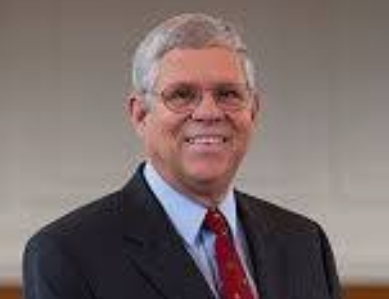
Gentry note: As I continue daily research for my next book, I have stumbled on a helpful one titled Jesus, Paul and the End of the World by Ben Witherington (IVP 1992). Dr. Witherington is Professor of New Testament Interpretation at Asbury Theological Seminary and a widely recognized scholar who has written over sixty books on a variety of biblical issues and from leading evangelical publishers. Although I do not endorse everything he states in this work, he has many valuable, well-researched, deeply-exegetical insights that have been profitable for me. This is only an excerpt from pages 187–191 of this work. There is a lot of surrounding context that is necessary for grasping the full force of his argument. But this ought to whet your appetite. And steer you clear from the proto-Gnosticism of hyper-preterists who see the resurrection body as an ethereal, spiritual reality rather than a corporeal, material one.
That which follows is by Witherington and is cited from his from Jesus, Paul and the End of the World:
In 1 Thessalonians 1:10 Christ’s resurrection is connected with the believer’s future deliverance from God’s wrath. In fact, almost always when Paul speaks of Christ’s resurrection he does so in connection with the events that will transpire when Christ returns. He clearly does not see Christ’s resurrection as an isolated historical anomaly but as an eschatological event that is the harbinger and in some sense the trigger or at least the prerequisite of future eschatological events. Paul is surely dealing with Christians in Thessalonica who had speculated about such eschatological matters, and it may even be that the Thessalonian Christians were reflecting the characteristics of a millenarian movement. If so, then it would appear that Paul is trying to offer a certain amount of “eschatological reserve” while still affirming much of the substance of the Thessalonians’ beliefs about the future. Here Paul grounds the believer’s future status in the belief in the past Christ-event.
I have already dealt with 1 Thessalonians 4:14 in the previous chapter but note here that the future resurrection of deceased believers is linked with the past death and resurrection of Jesus. The link here, however, is unlike that in 1 Corinthians 15. Here belief in Christ’s resurrection is seen as the proper grounds for believing that deceased Christians will likewise be raised. Verse 16 also makes clear that Paul is only referring to the future of “the dead in Christ,” that is, dead Christians. Christ’s resurrection is not a guarantee or proof of the future general resurrection of all the dead. Finally, since in verse 17b Paul says “and so [or ‘in this way’– kai houtōs] we shall be with the Lord forever [pantote],” this must count strongly against the idea that this text is talking about some interim stay with Christ in heaven during a period of earthly tribulation.
GOODBIRTH AND THE TWO AGES
I am currently researching a technical study on the concept of the Two Ages in Scripture. This study is not only important for understanding the proper biblical concept of the structure of redemptive history. But it is also absolutely essential for fully grasping the significance of the Disciples’ questions in Matthew 24:3, which spark the Olivet Discourse. This book will be the forerunner to a fuller commentary on the Olivet Discourse in Matthew’s comprehensive presentation. This issue must be dealt with before one can seriously delve into the Discourse itself.
If you would like to support me in my research, I invite you to consider giving a tax-deductible contribution to my research and writing ministry: GoodBirth Ministries. Your help is much appreciated!
This brings up a very crucial point that I shall develop at length when we turn to 1 Corinthians 15, but it bears mentioning here. For Paul resurrection means final conformity to the likeness or image of God’s Son, even in regard to one’s body. In other words, resurrection seems to have a very specific positive content that has to do with the consummation of Paul’s ideas about the imitatio Christi. In such a context it is hardly surprising that Paul never speaks of the resurrection of nonbelievers. If one has not participated in the process of being conformed to the image of the Son in this life (Rom 8:29), it is hardly to be expected that one would get the final installment or completion of this ongoing process later. Resurrection ushers the believer into the new world and the kingdom promised to them by God. Vos has it right when he says:
“If we may judge of the resurrection of believers mutatis mutandis after the analogy of that of Christ, we shall have to believe that the event will mark the entrance upon a new world constructed upon a new superabundantly dynamic plane. . . . The resurrection constitutes, as it were, the womb of the new aeon, out of which believers issue as, in a new, altogether unprecedented sense, sons of God…. The analogy and its bearing upon our problem become most clear when the passage Rom. 1:3–4 is somewhat closely analyzed…. The Resurrection (both of Jesus and of believers) is therefore according to Paul the entering upon a new phase of sonship characterized by the possession and exercise of unique supernatural power.”
The truth of this observation will become readily apparent when we examine Romans 1 and 1 Corinthians 15 more fully below. However, I submit that this theological truth already stands behind what Paul says in texts like 1 Thessalonians 3:13 and 5:23 where the ongoing process of sanctification is seen as preparation for the coming of Christ. The work of the Spirit in the present in the believer is preparing that believer not only for the final judgment of Christ, but for the final work of the Spirit for the believer, that is, resurrection in the likeness of Christ’s glorified body. For Paul, Christology, pneumatology, soteriology, eschatology and ethics are so closely interwoven that any attempt to treat one or another of these aspects of Paul’s thought in isolation from the others does less than justice to them all. This is especially true when we come to what is for Paul a sine qua non of Christian faith — the belief in both Christ’s and the believer’s resurrection.\
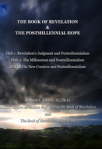 The Book of Revelation and Postmillennialism (Lectures by Ken Gentry)
The Book of Revelation and Postmillennialism (Lectures by Ken Gentry)
In the first of these three 50-minute lectures Gentry explains Revelation’s judgments to show they do not contradict postmillennialism. In the next two lectures he shows how the Millennium and the New Creation themes strongly support the gospel victory hope found in postmillennialism.
See more study materials at: www.KennethGentry.com
One last aspect of Paul’s discussion in 1 Thessalonians 4:14–17 bears scrutiny. Resurrection here, as in 1 Thessalonians 1:10, has to do with something that happens to a dead person, not a living one. First Thessalonians 4:17 may imply that some similar transformation will happen to living believers but it is not called resurrection here. Since 2 Thessalonians adds nothing to our discussion, we will pass on to 1 and 2 Corinthians.
The first passage under consideration, 1 Corinthians 6:14, comes in the middle of Paul’s discussion about the proper use of the human body. Resurrection is introduced here to explain why it is important to act morally in and with the body — body is meant for the Lord and in fact will participate in the eschatological state of salvation. Verse 14 makes the analogy between Christ’s resurrection and that of believers quite explicit. Both are raised up by God’s power. The context makes clear that by resurrection Paul means something involving a body. In view of the future verb katargesei in verse 13, the future exegerei is surely to be preferred in verse 14 (compare 2 Cor 4:14). Again we see a clear connection made between the believer’s present condition and conduct and his future condition. Ethics circumscribes bodily conduct because the body has a place in the eschatological future of the believer. Paul is countering the “spiritualizing” tendencies of Corinthian eschatology and soteriology. “This affirmation stands in bold contrast to the Corinthian view of spirituality which looked for a ‘spiritual’ salvation that would finally be divested of the body.”
There has been much debate over what Paul is combating in 1 Corinthians 15. On the surface of things verse 12 seems to give a straightforward answer — some in Corinth were saying, “there is no resurrection of the dead.” Paul attributes this view to only “some” (tines), but these some were evidently sufficient in number and/or in importance in the Corinthian church for Paul to correct the problem in this letter to the church as a whole. Indeed, the space Paul devotes to this problem suggests that it is part of the larger general problem in Corinth of what may be called spiritualized eschatology, which Paul has been correcting all along in this letter.
House Divided: The Break-up of Dispensational Theology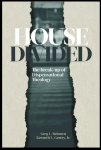 By Greg Bahnsen and Ken Gentry
By Greg Bahnsen and Ken Gentry
This book presents and defends Christian Reconstruction theology, particularly theonomic ethics and postmillennial eschatology. It does to by responding to dispensationalism’s social and exegetical theology.
For more educational materials: www. KennethGentry.com
Could these “some” be the same ones who were also baptizing for the dead? It is often pointed out that the practice of baptizing for the dead surely implies some hope about the future of the deceased ones for whom proxy baptism is being undertaken. Paul, by implication, certainly seems to think there is some connection, at least in the minds of those receiving this peculiar baptism, between this practice and one’s hope for the future of these deceased persons. What is not clear from verse 29 is whether that future hope entailed a hope for some sort of resurrection or rather some sort of less material participation in eternal life. Paul does not specifically identify the some who are denying the resurrection with “those” who are receiving proxy baptism.
It also seems reasonable to maintain that if Paul in 1 Corinthians 15:12 had future resurrection, he would have said anastasin ēdē gegonenai not anastasis ouk estin.
Perhaps the problem lies with the fact that we have overlooked the qualifier in verse 12 — what is being denied is not just “resurrection” simpliciter but resurrection of the dead (nekron). A. J. M. Wedderburn asserts “that ‘resurrection’ would mean, especially to Hellenistic readers, something physical, earthy, which only gradually came to be spiritualized as groups of Christians… sought to reconcile their Hellenistic or gnostic aversion to the body with the ineluctable of the idea of resurrection in … Christian tradition.”
However, there is evidence in 1 Corinthians that at least some of the Corinthians themselves already had been involved in such a spiritualizing of matters. Besides the fact that a case can be made for some proto-Gnostic tendencies in Corinth, if 1 Corinthians 6:13b is a quote of the Corinthian’s view that God will destroy the body, thus implying that salvation has nothing to do with it, or if in fact 1 Corinthians 4:8 ascribes to various Corinthians an overrealized, as well as an overly pneumatic, view of salvation in which the new life called by Christians “resurrection” is seen as a matter of life in the Spirit here and now, it is not hard to believe that some Corinthian Christians were denying “resurrection of the dead.” Wedderburn says, “For the Corinthians what they treasure as life-giving and divine is the pneuma specially granted to them and not the psyche which is in every [one].” Resurrection of dead persons might well have connoted to such Corinthians “the standing up of corpses” (see Acts 17:31–32). This would have seemed repugnant to those who saw salvation/new life in a purely spiritual vein, whether in this life or the next.
 The Beast of Revelation (246pp); Before Jerusalem Fell: Dating the Book of Revelation (409pp); Navigating the Book of Revelation: Special Studies on Important Issues (211pp).
The Beast of Revelation (246pp); Before Jerusalem Fell: Dating the Book of Revelation (409pp); Navigating the Book of Revelation: Special Studies on Important Issues (211pp).
In the Logos edition, these volumes by Ken Gentry are enhanced by amazing functionality. Important terms link to dictionaries, encyclopedias, and a wealth of other resources in your digital library. Perform powerful searches to find exactly what you’re looking for. Take the discussion with you using tablet and mobile apps. With Logos Bible Software, the most efficient and comprehensive research tools are in one place, so you get the most out of your study.
For more study materials, go to: KennethGentry.com
Thus we should not try to envision a group of Christians in Corinth who flatly denied “resurrection,” whether Christ’s or believers’ per se. Paul would hardly have addressed such persons as adelphoi (15:1), in view of how strongly he feels about resurrection being a sine qua non of Christian faith (see 15:12–19). Nor would he have reminded them that they had already believed in the resurrection if it were not so (15:11). Rather, he is trying here to correct an overly spiritual and an overrealized view of resurrection. He corrects the former by stressing that resurrection involves a body. He corrects the latter by setting forth a sketch of the order of future eschatological events, including resurrection of the dead. The Corinthians apparently thought the body was at best something inferior, temporary, of no eternal significance, and at worst some of them may have seen matter as tainted or even evil. In either case they did not envision eternal life/resurrection as involving a body. This is not surprising in an environment where the dominant idea of immortality was still the immortality of the soul. K. A. Plank sums up the matter well:
“The problem in Corinth is not the denial of the kerygma but its enthusiastic interpretation: the scandal of the crucified Messiah has been overcome by an through sacramental realism that understands redemption to have already uncontrolled exaltation christology; obedience to his lordship has been lost through sacramental realism that understands redemption to have already been effected. The difficulty is not the failure of the Corinthians to believe in the resurrection, Christ’s or their own, but the fact that they believed “too much”!… To oppose the Corinthian position and be true to his own Paul must be both “for and against a theology of the resurrection.”
Thus, ends Witherington citation. To read his full argument, purchase the book at: Amazon
April 4, 2025
PRETERIST POSTMILL SYSTEMATIC THEOLOGY
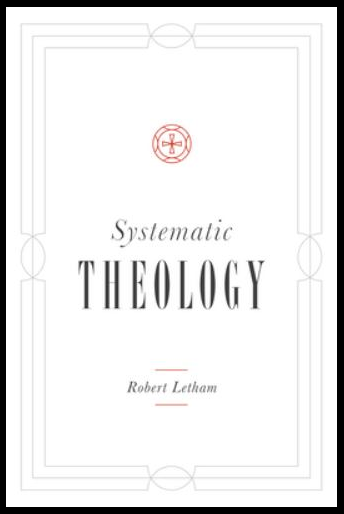 PMW 2025-026 by Kenneth L. Gentry, Jr.
PMW 2025-026 by Kenneth L. Gentry, Jr.
INTRODUCTION
I frequently receive requests from readers seeking preterist and/or postmillennial works released by established publishers.[1] There are plenty of self-published and small-publisher releases available. I have recommended a few in the past and hope to continue doing so in the future. So, in this posting I will highly recommend an excellent systematic theology that is not only written by a prominent Reformed theologian, but is also (partial) preterist [2] and postmillennial in orientation: Robert Letham’s Systematic Theology (2019). Since this blog is fundamentally about eschatological issues, I will focus on Letham’s comments relevant to this locus of theology.
Robert Letham, Ph.D. (University of Aberdeen) is professor of systematic and historical theology at Union School of Theology. His Systematic Theology is published by Crossway, and endorsed by Joel R. Beeke, Sinclair B. Ferguson, Carl R. Trueman, Cornelis P. Venema, and Alan D. Strange — competent theologians one-and-all!
As a caveat, I would point out up front that Letham is moderately preterist. That is, he does not seem to hold to a fuller form of (partial) preterism such as I hold. But it is refreshing to read his treatment of the Olivet Discourse, which follows in the main that of Charles Spurgeon, J. M. Kik, Harold Fowler, R. T. France, J. A. Gibbs, David Garland, A. I. Wilson, Jeannine K. Brown — and me. You may purchase this excellent Systematic Theology at Amazon.
We can sense his revulsion regarding hyper-preterism when he warns that today we are experiencing Gnostic-influenced views within some evangelical circles that deny the resurrection of the body. Over against this hyper-preterist view, Letham cleverly and powerfully states that “creation, incarnation, and resurrection underline the fact that to God, matter matters” (pp. 278–79). Thus, he laments the arising of hyper-preterism, which he deems “a cult revival of sorts,” for in this theological system “we are faced by more than a deviant eschatology; it is heresy” (p. 848). [3]
Have We Missed the Second Coming: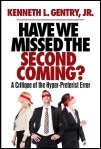
A Critique of the Hyper-preterist Error
by Ken Gentry
This book offers a brief introduction, summary, and critique of Hyper-preterism. Don’t let your church and Christian friends be blindfolded to this new error. To be forewarned is to be forearmed.
For more Christian educational materials: www.KennethGentry.com
But now, let us consider his brief treatment of the Olivet Discourse in pp. 831–34. The remaining paragraphs are from Letham (except for my advertisements!):
LETHAM’S SYSTEMATIC THEOLOGY (pp. 831–34)
Israel and the Mosaic Covenant
Matthew 24-25. For this significant discourse of Jesus’s, the parallel passage in Luke 21 is important. There Jesus answers a question about the imminent destruction of the temple.
Possible interpretations. The most common interpretations of Matthew 24–25 are as follows: (1) Verses 1–35 were fulfilled in AD 70, whereas 24:36–25:46 refers to the parousia. (2) All is to be fulfilled at the parousia. (3) There was a fulfillment at AD 70 and another at the parousia, moving from one to the other throughout the passage, although without unanimity about exactly where these transitions occur. (4) The passage refers to the entire period from the resurrection to the end.
The questions. The context was Jesus’s departure from the temple, whereupon the disciples remarked about the temple buildings. The departure was significant, since Jesus would not return; it was more than a merely physical departure. Matthew recorded steadily increasing antagonism from the religious establishment toward Jesus. In chapter 23 this reached a climax as Jesus denounced his antagonists for their wicked unbelief. The time had arrived for the judgment of God, for the covenant sanctions to hang like the sword of Damocles over the nation. Jesus replied to the disciples that the temple would be overthrown. Not one stone would be left (24:2). His departure demonstrated that judgment was imminent. This exchange is mirrored in Luke 21:5–6, where the disciples’ comments focus explicitly on the beauty of the temple buildings, but Jesus’s answer is effectively the same. The temple was the focal point of Yahweh’s covenant relationship with Israel; its destruction signaled the overthrow of all they held dear and the inauguration of the new covenant. This set the scene for what would follow.
Olivet Discourse Made Easy (by Ken Gentry)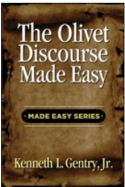
Verse-by-verse analysis of Christ’s teaching on Jerusalem’s destruction in Matt 24. Shows the great tribulation is past, having occurred in AD 70, and is distinct from the Second Advent at the end of history. Provides exegetical reasons for a transition from AD 70 to the Second Advent at Matthew 24:36.
See more study materials at: www.KennethGentry.com
The disciples raised questions (Matt. 24:3): “When will these things 24:3 be, and what will be the sign of your coming [parousia] and of the end of the age?” These appear to have been two distinct questions. However, in the minds of the disciples, it is likely that they were one. It would be 34 unthinkable that the end of the age was something separable from the overthrow of the temple, the place where Yahweh and his people met in covenant relationship, with the priesthood and the sacrifices. From their angle, Jesus was speaking about the day of the Lord, the end and fulfillment of the covenant. Jesus’s answer was not what they had expected. Jesus warned against premature conclusions that might arise from dramatic events around them (24:5–14). There might be enticing voices purporting to know that the end was near, that the temple’s days were done, that the existing order was about to be overthrown. Some would claim to be the Messiah (v. 5). There would be wars and crises (v. 6), natural disasters and recurrent famines (v. 7). Persecution was to break out, and some would be martyred (vv. 9–13). The gospel was to be preached “throughout the whole world” (v. 14); only then would the end come. Natural disasters, political upheavals, and persecution were not signs of the imminence of the temple’s overthrow. They were all features of life in a fallen world, marked by social disorder, typified by disruption and conflict.
Instead, a range of distinct signs would immediately precede the event. Jesus mentioned “the abomination of desolation spoken of by the prophet Daniel, standing in the holy place” (v. 15). In Luke the reference is to “Jerusalem surrounded by armies [infantry or foot–soldiers]” (Luke 21:20), pointing to the Roman armies besieging the city in the Jewish revolt. In Matthew, the reference points to the blasphemous action of Titus Vespasian in entering the temple and proclaiming his divine status. Daniel’s vision looks down the centuries to a similar action in 165 BC when Antiochus Epiphanes IV, following a siege and a time of intense persecution of the Jews, who were led by the Maccabees, offered a sow on the temple altar, an event strikingly similar to the one mentioned here.
Understanding the Olivet Discourse 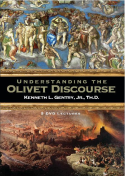
By Ken Gentry
This 5 DVD lecture set was filmed at a Bible Conference in Florida. It explains the entire Olivet Discourse in Matt. 24–25 from the (orthodox) preterist perspective. This lecture series begins by carefully analyzing Matt. 24:3, which establishes the two-part structure of the Discourse. It shows that the first section of the Discourse (Matt. 24:4–35) deals with the coming destruction of the temple and Jerusalem in AD 70. This important prophetic event is also theologically linked to the Final Judgment at the end of history, toward which AD 70 is a distant pointer.
For more educational materials: www. KennethGentry.com
In the face of this very public sign Jesus instructed his followers to escape for their lives (Matt. 24:17–22). This would be an unparalleled time of suffering, for “there will be great tribulation, such as has not been from the beginning of the world.” Over one million perished in the siege of AD 70, with cannibalism common. In view of the downfall of Jerusalem and the destruction of the temple, it seemed that all for which Israel had hoped for so long was in ruins. The calamity was colossal. It demonstrated publicly that the Mosaic covenant had ended, its sanctions enforced.
During this time, false hopes would be rife. Many would claim special revelation, signs and wonders would be on display, and reports of the arrival of the Messiah would alarm many. None of these portents were to be accepted by Jesus’s disciples (vv. 23–26) for the parousia of the Son of Man was to be of a very different order, universally evident, raising no doubts or questions (v. 27). In the case of the temple and Jerusalem, the eagles would be surrounding the carcass, the armies ready in predatory mode to gorge themselves on the decadent Jewish state and corrupt temple establishment (v. 28).
The apocalyptic language that follows is reminiscent of Isaiah 13:10ff., where the prophet foretold the downfall of Babylon (Matt. 24:29). There a mighty world power was brought to its knees; here the nation God had taken for his own and nurtured was to be struck down — political convulsions both, portrayed in vivid Technicolor. Something like this is portrayed in verse 30, with the sequel in verse 31, where God sends his messengers to gather his elect throughout the world. This suggests the Gentiles being gathered into the kingdom of heaven, in keeping with the overall thrust of Matthew (1:1; 8:11–12; 28:19–20), rooting the apocalyptic language and the remarkable signs in the events of AD 70, the Son of Man coming in judgment on Israel.
This conclusion is reinforced by the parable of the fig tree, which follows in Matthew 24:32–34. It points to the preceding signs as immediate precursors of the end, of the Son of Man acting in judgment. Jesus reinforces the point by affirming that “this generation will not pass away until all these things take place.” The clearest meaning of this comment is that the temple will be destroyed within the lifetime of the generation hearing Jesus’s words. The parallel passage in Luke 21 is effectively identical to Matthew 24:1–35 and explicitly addresses the question of the overthrow of the temple. Moreover, Matthew has focused on the increased tension between Jesus and the establishment, with Jesus launching a barrage of condemnation on the unbelief and hypocrisy of the scribes and Pharisees. They were to bear the accumulated wrath of God from previous times (Matt. 23:35). The clincher is that “all these things will come upon this generation” (Matt. 23:36). The evidence points overwhelmingly to the current generation being called to account.
In the sections following, from verse 36, very different circumstances prevail. Until now there has been a great deal of detail, with many signs preceding the event in view. From verse 36 there is no forewarning of the event Jesus has in mind. In each case it happens suddenly and unexpectedly. Whereas the temple is to be destroyed following the abomination of desolation and the portents in heaven, “the parousia of the Son of Man” (v. 37) is foreshadowed by nothing at all. The comparison with the days of Noah (vv. 37–41) and the parables of the householder (vv. 42–44), the wise servant (vv. 45–51), the wise and foolish virgins (25:1–13), and the talents (25:14–30) all stress that “you do not know on what day your Lord is coming” (Matt. 24:42). The conclusion is that Jesus is talking about two different happenings―Jerusalem and its defeat in 24:1–35, and his parousia from 24:36–25:46. The disciples may have thought the overthrow of the temple would mark the end of the age but, in reality, these are two distinct events separated by indefinite time.
The passage highlights the importance of the events of AD 70. It removes the idea of the “great tribulation” (v. 21), from the realm of events that are still to happen before the return of Christ. The dominance of claims of a period of unspeakable persecution in the future has dered a pessimistic outlook on the ministry of the church, implying that things will go from bad to worse. If this were to be the case, I suggest it could not be based on the Olivet Discourse.
_______________________
Notes
1. By the way, if you run across any books along these lines, send me a note. I like to try to keep track of such publications — and promote them. If you don’t find any books along these lines, please do not send an email to me. I hate receiving empty emails. They take up too much air.
2. I hate that I have to qualify “preterist” with “partial,” but since the rise of hyper-preterism it has become necessary to do so. It is true that the orthodox form of preterism is “partial” in that it does not interpret every prophetic text as demanding past fulfillment. Yet it is still annoying because “preterism” has long been a term that spoke clearly enough of its standard meaning. Partial preterism is a useful hermeneutical tool that helps explain a good number of prophetic texts in the NT. It is not a wholesale theological system re-working and undermining orthodox Christian doctrine. But in the minds of the general Christian public “preterism” now carries a foreboding sense, which we should avoid. I also hate that the rainbow no longer represents God’s gracious promise but now represents Sodom’s grievous perversion.
3. Most orthodox, evangelical Christians hold that hyper-preterism (aka full preterism, consistent preterism, etc.) is heretical. Consider Joel R. Beeke and Paul M. Smalley in their 2024 Reformed Systematic Theology (v. 4: p. 941): “full preterism is a heresy that strikes at the heart of the Christian faith…. [And its adherent] should not be granted membership in local churches.” On p. 967 they write: “full preterists deny the resurrection of the body. These are serious errors, for the denial of the future resurrection is subversive to the faith (2 Tim. 2:17-18) — a heresy worthy of excommunication (1 Tim. 1:20). ” Furthermore, they observe that “the denial of Christ’s return undermines the doctrine of the incarnation” (p. 949).
Click on the following images for more information on these studies:
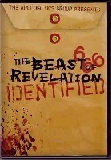

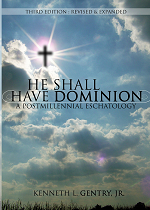
April 1, 2025
CORRECTING CONFUSION
 PMW 2025-025 by Kenneth L. Gentry, Jr.
PMW 2025-025 by Kenneth L. Gentry, Jr.
In this article I will be briefly responding to a reader that has been confused over some lexical and interpretive issues in eschatology. Hopefully this will help not only him but my other readers who may have experienced the same types of confusion.
The reader was interacting with my article “Understanding Collapsing Universe Prophecies” (PMW 2025-016) published on February 25, 2025.
The ends of the ages
He opens with: “The idea does not hold up that 2,000 years later we are still living in the same age as Paul and the Corinthian believers. Why? Because Paul wrote that the culmination of the ages had come upon them. (1 Corinthians 10:11).”
In response I would note that in fact we actually are living in the same age “as Paul and the Corinthian believers.” Paul simply means that with the incarnational coming of Christ in the first century, the final days, the end result of all the preceding, preparatory ages has finally come. Christ is the divider of history; he is the turning point in redemptive history. In the former days, all the OT sacrifices and types pointed to him, anticipating the finality of his work in the latter days, which was to come. And now that he has come the ends of the preceding ages has come. We live in the “last days” of history after which no other days of history will come. We are living in “the last days” in anticipation of “the last day,” which comes at the end of history, at the resurrection of the dead (John 6:39-40, 44, 54; 11:24).
Reformed Eschatology in the Writings of Geerhardus Vos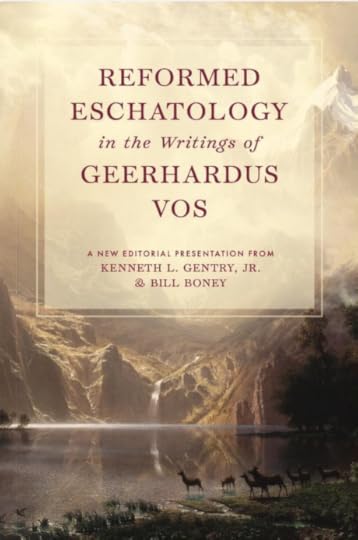
Ed. by Ken Gentry and Bill Boney
This is a collection of several key eschatological studies by the renowned Reformed theologian Geehardus Vos. We have modernized Vos’ grammar and syntax and updated his layout style according to modern publishing conventions (shorter sentences and paragraphs). We did this without changing any of Vos’ arguments.
For more information on this new Vos work or to order it, see:
https://www.kennethgentry.com/reformed-eschatology-in-the-writings-of-geerhardus-vos/
My reader then points to Matthew 12:32 which speaks of God not forgiving blasphemy against the Holy Spirit “either in this age or in the age to come [Gk. mellonti, a form of mello].” This helps my point. Jesus is not saying, blasphemy of the Holy Spirit will not be forgiven while I am here with you for it will not even be forgiven forty years later (when the temple is destroyed). He is stating in a dramatic, emphatic way that blasphemy against the Holy Spirit will never be forgiven — in history or in eternity.
Then my reader turns to Paul’s statement in Ephesians 1:21. That verse in context reads: “which He brought about in Christ, when He raised Him from the dead and seated Him at His right hand in the heavenly places, far above all rule and authority and power and dominion, and every name that is named, not only in this age but also in the one to come [Gk. mellonti, a form of mello].” Once again, this is a declaration of time and eternity. Christ is the head over all rule and authority — in history and in eternity.
I will have much to say about the biblical references to “this age” and “the age to come” in my book on The Two Ages of Redemptive History. However, there is much good material available out there. Simply looking up the verses in most standard commentaries will expose the error involved in the questions presented to me.
[image error]For more information and to purchase click here.
" data-image-caption="" data-medium-file="https://postmillennialworldview.com/w..." data-large-file="https://postmillennialworldview.com/w..." class="alignright size-full wp-image-213" src="https://postmillennialworldview.com/w..." alt="Predestination Made Easy" width="102" height="150" />Predestination Made Easy
(by Ken Gentry)
A thoroughly biblical, extremely practical, and impressively clear presentation of
the doctrine of absolute predestination.
See more study materials at: www.KennethGentry.com
The Greek mello
And now, what about the word mello? Many lay interpreters make the mistake of thinking that a Greek word has only one meaning. But if you look at the size of a Greek lexicon, you will realize that words have a great variety of shades of meaning and application. Certainly Mello can mean “about to” in the sense of approaching nearness. However, in the Bauer-Arndt-Gingrich-Danker Lexicon you will discover that the entry for mello consumes two and one-half columns of small print on large pages in explaining the meaning and use of the word. It does not simply say: Mello: “about to, to be on the point of.”
It gives the following definition(s) in its several columns: “(1) To take place at a future point of time and so to be subsequent to another event, be about to.” In sub-point (a) under entry (1) we discover that it sometimes “denotes certainty that an event will occur in the future” (Acts 27:10). Under sub-point (b) it is noted that it can mean “be on the point of, be about to.” But under sub-point (c) we discover that in addition to “about to” it can be used “in a weakened sense [to] serve simply as a periphrasis for the fut[ure],” e.g., Acts 13:34; 1 Tim. 1:16; 2 Pet. 2:6. As we continue further under point (1) the BAGD Lexicon points out that it can denote “an intended action” meaning “intend, propose, have in mind” (John 7:35; 2 Pet. 1:12).
But under point (2) in the BAGD Lexicon it gives this meaning: “to be inevitable, be destined, inevitable” (Acts 2:38; Rom. 4:24; 8:13; Heb. 1:14). Then at point (3) it says that it has the meaning of “(in the) future, to come” (Luke 13:9; Rom. 5:14; 8:38).
In fact, thfe internationally prominent BAGD Lexicon puts both Matt. 12:32 and Eph. 1:21 under the third definition: “(in the) future, to come.”
The Exegetical Dictionary of the New Testament has in its opening summary definition of mello: “intend, be about to, will (as auxiliary vb. for the fut.), be destined to, consider, hesitate, delay.” In one of its paragraphs it lists Eph. 1:21 as an example of meaning “coming, future.”
I dealt with the issue of mello two years ago (see: https://postmillennialworldview.com/2023/02/02/hyperpreterism-and-mello-in-acts/). But despite pointing out the scholarly exegetical and translational consensus, too many laymen keep following this faulty understanding.
BEFORE JERUSALEM FELL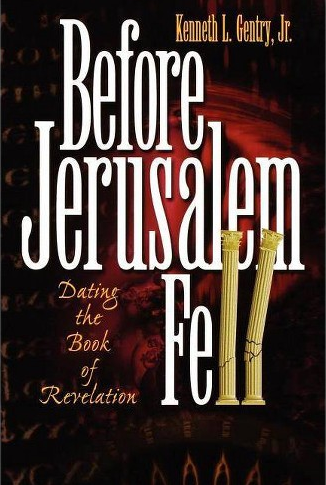
Doctoral dissertation defending a pre-AD 70 date for Revelation’s writing (459 pp; paperback). Thoroughly covers internal evidence from Revelation, external evidence from history, and objections to the early date by scholars.
For more study materials: https://www.kennethgentry.com/
The Bible translations
This is why published translations of Scripture have mello in Ephesians 1:21 as simply “to come,” not “about to come.” Notice the following versions (for the full version names see the bottom of this URL: https://www.biblegateway.com/verse/en/Ephesians%201%3A21).
KJ21
far above all principality and power and might and dominion, and every name that is named, not only in this world, but also in that which is to come.
ASV
far above all rule, and authority, and power, and dominion, and every name that is named, not only in this world, but also in that which is to come:
AMP
far above all rule and authority and power and dominion [whether angelic or human], and [far above] every name that is named [above every title that can be conferred], not only in this age and world but also in the one to come.
AMPC
Far above all rule and authority and power and dominion and every name that is named [above every title that can be conferred], not only in this age and in this world, but also in the age and the world which are to come.
BRG
Far above all principality, and power, and might, and dominion, and every name that is named, not only in this world, but also in that which is to come:
CSB
far above every ruler and authority, power and dominion, and every title given, not only in this age but also in the one to come.
CEB
far above every ruler and authority and power and angelic power, any power that might be named not only now but in the future.
CJB
far above every ruler, authority, power, dominion or any other name that can be named either in the ‘olam hazeh or in the ‘olam haba.
CEV
There Christ rules over all forces, authorities, powers, and rulers. He rules over all beings in this world and will rule in the future world as well.
DARBY
above every principality, and authority, and power, and dominion, and every name named, not only in this age, but also in that to come;
DLNT
far above all rule and authority and power and lordship and every name being named— not only in this age, but also in the one coming.
DRA
Above all principality, and power, and virtue, and dominion, and every name that is named, not only in this world, but also in that which is to come.
ERV
He put Christ over all rulers, authorities, powers, and kings. He gave him authority over everything that has power in this world or in the next world.
EASY
There, Christ rules over every other ruler and leader. He rules over everything else that has authority. He is greater than any power which people respect. That is true for the rulers of this world now, and also the rulers of the world that will come.
EHV
far above all rule, authority, power, and dominion, and above every name that is given, not only in this age but also in the one to come.
ESV
far above all rule and authority and power and dominion, and above every name that is named, not only in this age but also in the one to come.
ESVUK
far above all rule and authority and power and dominion, and above every name that is named, not only in this age but also in the one to come.
EXB
God has put Christ ·over [far above] all rulers, authorities, powers, and ·kings [lords; dominion], and every other ·title given [L name that is named] not only in this ·world [age] but also in the ·next [coming one].
GNV
Far above all principality, and power, and might, and domination, and every Name, that is named, not in this world only, but also in that that is to come,
GW
He is far above all rulers, authorities, powers, lords, and all other names that can be named, not only in this present world but also in the world to come.
GNT
Christ rules there above all heavenly rulers, authorities, powers, and lords; he has a title superior to all titles of authority in this world and in the next.
HCSB
far above every ruler and authority, power and dominion, and every title given, not only in this age but also in the one to come.
ICB
God made Christ more important than all rulers, authorities, powers, and kings. Christ is more important than anything in this world or in the next world.
ISV
He is far above every ruler, authority, power, dominion, and every name that can be named, not only in the present age, but also in the one to come.
PHILLIPS
That power is the same divine power which was demonstrated in Christ when he raised him from the dead and gave him the place of supreme honour in Heaven—a place that is infinitely superior to any conceivable command, authority, power or control, and which carries with it a name far beyond any name that could ever be used in this world or the world to come.
JUB
far above all principality and power and might and dominion and every name that is named, not only in this age, but also in that which is to come,
KJV
Far above all principality, and power, and might, and dominion, and every name that is named, not only in this world, but also in that which is to come:
AKJV
far above all principality, and power, and might, and dominion, and every name that is named, not only in this world, but also in that which is to come:
LSB
far above all rule and authority and power and dominion, and every name that is named, not only in this age but also in the one to come.
LEB
above all rule and authority and power and lordship and every name named, not only in this age but also in the coming one,
TLB
far, far above any other king or ruler or dictator or leader. Yes, his honor is far more glorious than that of anyone else either in this world or in the world to come.
MSG
All this energy issues from Christ: God raised him from death and set him on a throne in deep heaven, in charge of running the universe, everything from galaxies to governments, no name and no power exempt from his rule. And not just for the time being, but forever. He is in charge of it all, has the final word on everything. At the center of all this, Christ rules the church. The church, you see, is not peripheral to the world; the world is peripheral to the church. The church is Christ’s body, in which he speaks and acts, by which he fills everything with his presence.
MEV
far above all principalities, and power, and might, and dominion, and every name that is named, not only in this age but also in that which is to come.
MOUNCE
infinitely superior to every ruler, · authority, · power, or dominion—· every name that can be named—not only in · this age but also in the age to come.
NOG
He is far above all rulers, authorities, powers, lords, and all other names that can be named, not only in this present world but also in the world to come.
NABRE
far above every principality, authority, power, and dominion, and every name that is named not only in this age but also in the one to come.
NASB
far above all rule and authority and power and dominion, and every name that is named, not only in this age but also in the one to come.
NASB1995
far above all rule and authority and power and dominion, and every name that is named, not only in this age but also in the one to come.
NCB
far above every principality and authority, power and dominion, and every other title that can be named, not only in this age but also in the age to come.
NCV
God has put Christ over all rulers, authorities, powers, and kings, not only in this world but also in the next.
NET
far above every rule and authority and power and dominion and every name that is named, not only in this age but also in the one to come.
NIRV
There Christ sits far above all who rule and have authority. He also sits far above all powers and kings. He is above every name that is appealed to in this world and in the world to come.
NIV
far above all rule and authority, power and dominion, and every name that is invoked, not only in the present age but also in the one to come.
NIVUK
far above all rule and authority, power and dominion, and every name that is invoked, not only in the present age but also in the one to come.
NKJV
far above all principality and power and might and dominion, and every name that is named, not only in this age but also in that which is to come.
NLV
This place was given to Christ. It is much greater than any king or leader can have. No one else can have this place of honor and power. No one in this world or in the world to come can have such honor and power.
NLT
Now he is far above any ruler or authority or power or leader or anything else—not only in this world but also in the world to come.
NMB
above all rule, power, and might, and dominion, and above all names that are named, not in this world only, but also in the world to come.
NRSVA
far above all rule and authority and power and dominion, and above every name that is named, not only in this age but also in the age to come.
NRSVACE
far above all rule and authority and power and dominion, and above every name that is named, not only in this age but also in the age to come.
NRSVCE
far above all rule and authority and power and dominion, and above every name that is named, not only in this age but also in the age to come.
NRSVUE
far above all rule and authority and power and dominion and above every name that is named, not only in this age but also in the age to come.
NTFE
above all rule and authority and power and lordship, and above every name that is invoked, both in the present age and also in the age to come.
OJB
Far above all rule and authority and power and dominion, and every name that is named, not only in the Olam Hazeh but also in Olam Habah.
RGT
far above every principality and power and might and domination, and every name that is named, not only in this world, but also in the coming one.
RSV
far above all rule and authority and power and dominion, and above every name that is named, not only in this age but also in that which is to come;
RSVCE
far above all rule and authority and power and dominion, and above every name that is named, not only in this age but also in that which is to come;
TLV
He is far above any ruler, authority, power, leader, and every name that is named—not only in the olam ha-zeh but also in the olam ha-ba.
VOICE
He’s above all rule, authority, power, and dominion; over every name invoked, over every title bestowed in this age and the next.
WEB
far above all rule, authority, power, dominion, and every name that is named, not only in this age, but also in that which is to come.
WE
And God has put all things under Christ. He has made him the head of the church people in all matters.
WYC
above each principat, and potentate, and virtue, and domination, and above each name that is named, not only in this world, but also in the world to coming [and each name that is named, not only in this world, but also in the world to come];
YLT
far above all principality, and authority, and might, and lordship, and every name named, not only in this age, but also in the coming one.
Conclusion
When your view goes against the leading lexicons and the universal consensus of the published translations of Scripture, and your training in koine Greek is not complete, you have a problem. I recommend dropping the alternative minority view that is generally only held in a small, unorthodox movement.
GOODBIRTH AND THE TWO AGES
I am currently researching a technical study on the concept of the Two Ages in Scripture. This study is not only important for understanding the proper biblical concept of the structure of redemptive history. But it is also absolutely essential for fully grasping the significance of the Disciples’ questions in Matthew 24:3, which spark the Olivet Discourse. This book will be the forerunner to a fuller commentary on the Olivet Discourse in Matthew’s comprehensive presentation. This issue must be dealt with before one can seriously delve into the Discourse itself.
If you would like to support me in my research, I invite you to consider giving a tax-deductible contribution to my research and writing ministry: GoodBirth Ministries. Your help is much appreciated! https://www.paypal.com/donate/?cmd=_s-xclick&hosted_button_id=4XXFLGKEQU48C&ssrt=1740411591428
March 28, 2025
COMPREHENSIVE HOPE IN ESCHATOLOGY
PMW 2025-024 by Donald E. Gowan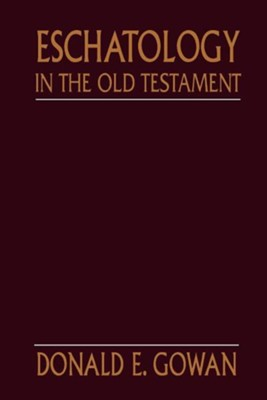
Gentry note:
The following is a series of thoughts selected from a very helpful book by Gowan on Eschatology on the Old Testament (pp. 122 ff.). Though he is not writing as a postmillennialist, he has many helpful observations that this article will share. His book basically argues for a holistic concept of redemption, both man (body and soul) and the broader creation (new heavens and new earth). He is not a conservative evangelical (as far as I can tell), but he is a good scholar insightful analyses of important eschatological issues.
Gowan’s Observations
The OT’s expectations and longings are distinct from those to be found in other religions and cultures. Thereby they offer a challenge for alternative forms of hope — Christian and otherwise — and insight into the nature of the eschatologies of the Western world.
1. Old Testament eschatology is a worldly hope. The OT does not scorn, ignore, or abandon the kind of life which human beings experience in this world in favor of speculation concerning some other, better place or form of existence, to be hoped for after death or achieved before death through meditation and spiritual exercises. This sets the OT in sharp contrast to Gnosticism, to the otherworldly emphases that often have appeared in Christianity, and to the concepts of salvation taught by Hinduism and Buddhism. Whether it is better and truer than those other forms of hope, or is just irredeemably “unspiritual,” remains, of course, a matter for faith to decide. But this quality of the OT hope surely ought to commend its outlook to an age that is equally worldly in its concerns.
2. Old Testament eschatology understands the future to be completely in the hands of God. Having just spoken of contemporary “worldliness,” which might be equated with secularism, this point must be made in order to remind ourselves that there are other ways to be worldly. The basis for hope in the OT is not faith in human progress, but the assurance of a coming divine intervention that will introduce a new thing that people have failed and will fail to accomplish. We have seen throughout that the hope of Israel was not an expression of faith in the essential goodness of humanity. Instead, it grew out of the conviction that human failure has so corrupted life on this earth that only a radical transformation initiated by God alone could make things right. This point of view thus stands in sharp contrast to modern humanism and to all “self-help” projections of the future.

Greatness of the Great Commission (by Ken Gentry)
An insightful analysis of the full implications of the great commission as given in Matthew 28:18-20. Impacts postmillennialism as well as the whole Christian worldview.
See more study materials at: www.KennethGentry.com
It does not, however, call for a completely passive drift into the divinely wrought paradise. The OT puts a strong emphasis on human participation in one way or another. Repentance, for example, is seen as essential, at some point in the process. The emphasis on obedience in the OT portraits of the ideal future shows that at no time does the OT conceive of human beings without responsibility. They participate actively in the new world, but they cannot produce it; that will be God’s work.
3. Old Testament eschatology emphasizes human society more than personal salvation. This stands in contrast to a strong emphasis in Christian teaching and to modern individualism as well. We have noticed that concern for the fate of the individual after death, which has tended to dominate Christian eschatology, is almost completely missing from the OT…. Certainly the OT does not ignore the redemption of individuals, but it puts its strongest emphasis on the truth that full human life is life in community. Already some who are seeking to respond theologically to the futurists’ identification of our root problem as selfishness have appealed to this biblical outlook. It would seem that it has still more to offer to those who are striving to find incentives to move people toward action that will improve our life together on a global scale.
4. Old Testament eschatology is a comprehensive hope. The OT neither focuses on an improved social structure inhabited by the same kind of people who created the mess we are now in; nor does it promise that personal salvation will somehow make social problems go away; neither does it imagine that a healthy human society can exist without a wholesome interaction with the natural world. I have already made brief comments on the potential ethical values of OT eschatology, and I wish to expand that subject now.
An Eschatological Ethic
Until recently, theological scholarship has tended to see eschatology as irrelevant for ethics if not actually working contrary to the concern for making human life better in this world. It seemed to divert one’s attention to heaven and the after-life and thus to be a very narrowly confined area of Christian thought. Carl Braaten, who has called eschatology “the key to Christian ethics,” has also had to admit that most contemporary ethicists completely ignore the subject, but there may be some signs of change. What theology is learning from the futurists concerning the intimate relationship between hope and action is likely to make a significant effect, and historical studies are also beginning to reveal that in practice eschatology often has had a powerful ethical component….
God’s Law Made Eas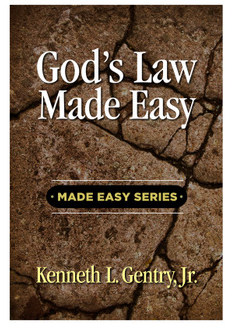 y
y
(by Kenneth Gentry)
Summary for the case for the continuing relevance of God’s Law. A helpful summary of the argument from Greg L. Bahnsen’s Theonomy in Christian Ethics.
See more study materials at: www.KennethGentry.com
Two aspects of the ethical implications of eschatology may be identified and designated as the object and the impetus. By object is meant what eschatology says human beings can and should be doing in the world, and by impetus is meant why eschatology impels us to want to do something about the present world. The object has been a topic for continual debate; this is what has made eschatology ethically dubious for many theologians. Is it possible to define some legitimate eschatologically motivated object for ethical action, that is, one that takes the eschaton to be truly future and completely the work of God, yet sees implications in this for human behavior in the present? At this point we recall Braaten’s definition of eschatological ethics: “it is the truly future eschatological kingdom of God-which has achieved a present impact in the person of Jesus and wherever the word of his presence exercises its creative power,” and then add to it something drawn from the understandings offered in this book. Anything that is truly future is inaccessible to any human being except as hope, but since the Bible’s central concern in speaking of the future is not time but evil, a limited participation in the eschaton as the end of evil is possible now, since God’s redemptive work is already in process. It is not yet the end, of time or of evil, but in faith we believe that we do participate in events and experience conditions that already possess something of the quality of the eschaton.
 Understanding the Creation Account
Understanding the Creation Account
DVD set by Ken Gentry
Formal conference lectures presenting important information for properly approaching the Creation Account in Genesis. Presents and defends Six-day Creation exegesis, while presenting and rebutting the Framework Hypothesis.
See more study materials at: www.KennethGentry.com
This approach may help to support the affirmations of some recent writers that the objects of eschatological ethics are to provide signs of the proleptic presence of God’s future.’ As Braaten says, they are annunciation and anticipation. We do not expect, then, to create the kingdom of God-within our Christian community as the Shakers did or in society at large as the Social Gospel did-but we believe it is possible for us to do some things that are indeed in correspondence with our understanding of what God is working toward. They will be witnesses to the truth of the future hope, reminders to believers, and perhaps also to others of what God is doing. What we do in an effort to make our behavior correspond with the way we believe the world day thus serves a dual purpose. On the one hand, we do some good things for other people. Where there is injustice, poverty, and illness, we do what we can to make things better for those people. Of course, eschatology is not the only incentive for such behavior; it is only one of several. But it makes a special contribution when we fail, as we regularly do. We never quite succeed in making things completely right, and sometimes we are complete failures. When that happens, in addition to the assurance of forgiveness there stands another assurance, that the future does not depend ultimately on us but on God. Whether we succeed or fail, our every effort to make things right is, therefore, a witness to the world that God is at work to Every little victory over evil is thus a reminder that the ultimate victory is bring about, someday, a time without suffering and anguish for everyone. Every little victory over evil is thus a reminder that the ultimate victory is coming….
How then does one live today, one who seriously affirms such hopes for God’s future? Would one even consider doing anything that is contrary to, or at cross-purposes with, or even neutral with respect to, what one’s eschatology affirms to be the ultimate purpose of God? Surely only hypocrisy or a definition of eschatology which the Bible will scarcely permit will allow that. For the biblical hope does not imply that in the meantime, before the last days arrive, God is neutral, just waiting for the time to come when he will intervene to make things right. God assures us that he is at work now and that what he is doing now is fully consistent with what will happen in that day. This is the obligation created by eschatology: to do our best to avoid doing anything contrary to what God is doing, and to be directed in our actions by our understanding of the direction of God’s work.
The attraction of eschatology is its most potent aspect, that which makes it ethically most dangerous or most helpful. It is a vision, a dream, and the power of dreams far surpasses any sense of obligation. It is sometimes merely a daydream about which we feel no need to do anything, but it need not be that. It is often the kind of dream which pulls us toward it, about which we cannot remain idle. Hope for the future is one of the strongest motivating forces to which we are subject, and since demagogues know that, some of them become highly skilled in using it. All the more reason for those who are committed to the biblical faith to recognize hope’s power and learn to use it for good.
GOODBIRTH AND THE TWO AGES
I am currently researching a technical study on the concept of the Two Ages in Scripture. This study is not only important for understanding the proper biblical concept of the structure of redemptive history. But it is also absolutely essential for fully grasping the significance of the Disciples’ questions in Matthew 24:3, which spark the Olivet Discourse. This book will be the forerunner to a fuller commentary on the Olivet Discourse in Matthew’s comprehensive presentation. This issue must be dealt with before one can seriously delve into the Discourse itself.
If you would like to support me in my research, I invite you to consider giving a tax-deductible contribution to my research and writing ministry: GoodBirth Ministries. Your help is much appreciated! https://www.paypal.com/donate/?cmd=_s-xclick&hosted_button_id=4XXFLGKEQU48C&ssrt=1740411591428
March 25, 2025
THE GOSPEL’S LAST DAY VERDICT
PMW 2025-024 by Dr. Ardel B. Caneday (from All Things Christian blogsite)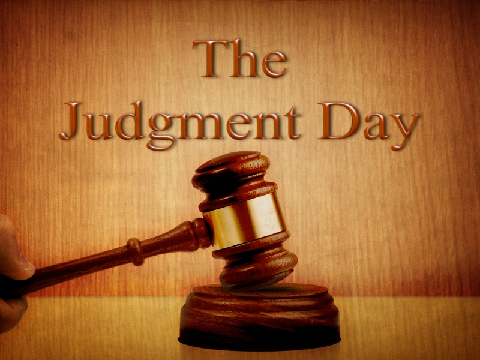
Gentry note: Below is an insightful article that comports with the evangelical and Reformed understanding of the Already/Not Yet principle of biblical interpretation. An excellent read! For 28 years Dr. Caneday served as Professor of New Testament & Greek at the University of Northwestern-St. Paul. He recently retired from full-time teaching and now serves as an adjunct professor at UNW.
Dr. Caneday’s article:
In December 2021, I published four articles responding to Harrison Perkins’s criticism of my chapter, “Covenantal Life with God from Eden to Holy City” in Progressive Covenantalism: Charting a Course between Dispensational and Covenantal Theologies. R. Scott Clark published the article on The Heidelblog. There, Perkins blatantly claimed, “In the end, Caneday does promote a salvation by works.” So outrageous was his accusation that I patiently responded with four articles demonstrating that his assessment and accusation were wrong and thus slanderous. Those accusations by Perkins, Clark, and others derive from their common failure to account for the New Testament’s presentation of the salvation of the Last Day brought forward in the person of Christ Jesus, consequently the already but not-yet character of salvation, including justification and forgiveness of sins, featured in this article.
Despite being available for more than four years, neither Perkins nor Clark have ever acknowledged their error of judgment nor repented of their published defamation. Though I did not write my recently published article at Christ Over All to counter Perkins’s false accusation published by Clark, it nonetheless does just that. Thus, though I rarely repost articles I have published elsewhere on this blog, I repost this article as a capstone to the earlier four-part series to expose the slanderous accusation written by Harrison Perkins and published on The Heidelblog.
All month, Christ Over All has focused on the question, “Whatever Happened to the Doctrine of Sin?”. Crucial as this is, it would be pointless and cruel if we did not address God’s glorious remedy for sin with its universal and individual consequences. Today, we redirect our focus to God’s merciful and gracious provision of his Son, to whom he imputed his wrath and punishment as our substitute, that he might acquit us sinners and remit our crimes against him. The Bible’s terms for these conjoined acts are “justification” and “forgiveness of sins,” featured in this article. The good news announces God’s Last Day verdict for everyone who believes in his Son—justified and sins forgiven.
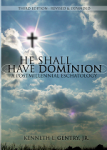
He Shall Have Dominion
(paperback by Kenneth Gentry)
A classic, thorough explanation and defense of postmillennialism (600+ pages). Complete with several chapters answering specific objections.
See more study materials at: www.KennethGentry.com
God Promised the Savior at the Beginning in Eden
In the Garden, God announced in advance his verdict of the Last Day on humans concerning sin: condemned to eternal death (Gen. 2:15–17). Thus, when the Serpent induced Adam (through Eve) to disobey God by eating fruit from the forbidden tree, sin’s indictment condemned the man and woman, with their progeny, to the punishment of death. Since then, every human born by the union of earthly parents has been subjected to the Creator’s same condemning verdict for sin, punishable by death in both the temporal and the eternal dimensions. Likewise, the Creator subjected the entire creation to futility in the hope of one day being liberated from its slavery to corruption—when God would redeem the bodies of his children by raising them from the dust (Gen. 3:19; Rom. 8:20–23). Thus, from the beginning, God revealed by way of prophetic prefiguring the ensuing cosmic war between the “Serpent’s seed” and the “woman’s seed,” the Coming One conceived not by the union of earthly parents but born of a woman nonetheless, who would crush the Serpent’s head—but not without the Serpent striking a wound to the Coming One’s heel (Gen. 3:15).[1]
Only the Coming One, born of a woman but uncreated, could remediate mankind’s and creation’s common plights—corruption and death. He entered his creation from heaven as the Second Man, the Last Adam, “a life-giving spirit” (1 Cor. 15:45–49). As the head of a new humanity, he would sweep forward into time the judgment of the Last Day by his obedience unto death, even death on a cross (Rom. 5:19; Phil. 2:8). Thus, the visitation of God’s Last-Day-wrath upon Christ in his death on the cross effected both (1) that “we shall be saved” from the coming “wrath of God” (Rom. 5:9) and (2) the dawn of the New Creation “by which the world has been crucified” to Christ’s people and they “to the world” (Gal. 6:14–15). Likewise, he brought forward the resurrection of the Last Day into the midst of history when he arose from the dead, which was his “justification” before God (1 Tim. 3:16; Rom. 1:4), thus grounding our justification (Rom. 4:25). Because Christ lives, we who are in him shall be saved by his resurrection life (Rom. 5:10). Hence, he makes all his progeny righteous (Rom. 5:19), fulfilling the prophet Isaiah (53:11) by creating a people born not from flesh and blood but from the Spirit (John 1:12–13).

As It Is Written: The Genesis Account Literal or Literary?
Book by Ken Gentry
Presents the exegetical evidence for Six-day Creation and against the Framework Hypothesis. Strong presentation and rebuttal to the Framework Hypothesis, while demonstrating and defending the Six-day Creation interpretation.
See more study materials at: www.KennethGentry.com
Jesus Brought Forward the Last Day Judgment and Resurrection
The vast glory of God’s gift of salvation in Christ obligates Christians to ponder the multifaceted imageries Scripture uses to portray its grace and beauty. God’s Word reveals salvation, eternal life, adoption, justification, sanctification, reconciliation, redemption, regeneration, remission of sins, resurrection, and other imageries as isolated doctrines or primarily past referring.[2]
All biblical imageries of salvation in Christ Jesus entail two phases or aspects: what Scripture presents as already occurring but not yet exhausted as God’s triumphant salvation entering the present age ahead of the Last Day with the advent of his Son. Jesus vividly dramatizes the presence of the Last-Day-resurrection at Lazarus’s tomb. He enhances and develops Martha’s correct belief in “the resurrection on the Last Day” by announcing, “I am the resurrection and the life. Whoever believes in me, though he die, yet shall he live, and everyone who lives and believes in me shall never die. Do you believe this?” (John 11:24–26). Jesus’s raising Lazarus from death’s grip signified that he brought forward into the present time “the powers of the coming age” (Heb. 6:5). This prefigured his resurrection. Likewise, Jesus preached that the not-yet resurrection of the Last Day already begins in this present age through the proclamation of the gospel: “Truly, truly, I say to you, an hour is coming and is now here when the dead will hear the voice of the Son of God, and those who hear will live” (John 5:25). The Son’s rising from the dead was the dawn of the last days.
In the same way, Scripture portrays salvation as already ours in Christ Jesus (Eph. 2:5, 8; Titus 3:5), but we have not yet received it exhaustively (Rom. 8:24; 13:11). Thus, Jesus instructs us that everyone who comes to faith in him to receive salvation must persevere to the end to be saved (Matt. 10:22). Hence, the frequent biblical imagery of the athlete sprinting forward from faith’s starting blocks endeavoring to lay hold of the prize who is Christ Jesus, to be found in him, to attain unto the resurrection from the dead (Phil. 3:8–11). As we ponder these imageries of God’s salvation in Christ Jesus, we need to believe and speak even-handedly, avoiding errors by exaggerating either the already or the not yet aspect to the suppression or exclusion of the other.[3] Among Christians, the error regularly occurs, overstating the already to the neglect of the not yet, portraying salvation as already possessed exhaustively. Hence, most Christians think of salvation as exclusively taking place in the past, testifying, “I am saved,” or asking, “Are you saved?”
Likewise, caution is necessary because of another mistake. Scripture does not present any of its multiple imageries of salvation in Christ Jesus as standalone doctrines to be detached from the many other portrayals. The Bible presents the revelation of God’s salvation through multiple variegated imageries, each like a single facet of a finely cut multifaceted diamond, together reflecting the glorious light shining forth from our Savior, Jesus Christ. No solitary imagery adequately displays the richness or fullness of Christ as our redeemer. Hence, when pondering Scripture’s theology, inevitably, we discern theological categories and thus do some level of systematic theology. For this reason, Christian theology is the activity of every believer, not just pastors, teachers, and academic theologians. Yet, we must never separate the many distinguishable imageries as isolated doctrines. For example, we must distinguish two imageries from the legal realm—justification and forgiveness of sins—but not isolate them. To emphasize this point, the remainder of this article will show how the Apostle Paul’s teaching obligates us to hold these two together.
GOODBIRTH AND THE TWO AGES
I am currently researching a technical study on the concept of the Two Ages in Scripture. This study is not only important for understanding the proper biblical concept of the structure of redemptive history. But it is also absolutely essential for fully grasping the significance of the Disciples’ questions in Matthew 24:3, which spark the Olivet Discourse. This book will be the forerunner to a fuller commentary on the Olivet Discourse in Matthew’s comprehensive presentation. This issue must be dealt with before one can seriously delve into the Discourse itself.
If you would like to support me in my research, I invite you to consider giving a tax-deductible contribution to my research and writing ministry: GoodBirth Ministries. Your help is much appreciated! https://www.paypal.com/donate/?cmd=_s-xclick&hosted_button_id=4XXFLGKEQU48C&ssrt=1740411591428
Two Correlated Imageries—Forgiveness & Justification
Paul contends that Jesus has already brought resurrection and divine judgment forward from the Last Day because God has already poured out his wrath on his Son on the cross. The Righteous One from heaven bore God’s wrath in the place of unrighteous people (Rom. 3:21–31). With his first advent, God’s Son brought forward two correlated acts of God—resurrection and judgment—that belong to the Last Day, which consummates the present age and ushers in the coming age. The gospel orients everyone to Christ’s cross as the public display of God’s wrathful judgment against sin, for Christ, who knew no sin yet was made sin for us, being condemned as our substitute (Rom. 3:21–31; 1 Cor. 1:18; 2 Cor. 5:21). Likewise, the gospel orients us to Christ’s resurrection as God’s vindication of his Son; Christ, the Righteous One, was acquitted by being raised from the dead for our acquittal (Rom. 1:4; 4:25; 1 Tim. 3:16). These two acts stand together as the advance visitation of God’s Last Day courtroom. All those in Christ Jesus are assured that Christ’s acquittal will be ours on that day. Thus, Paul preaches already “everyone who believes is justified” (Acts 13:39).
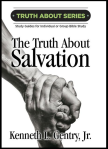 The Truth about Salvation By Ken Gentry
The Truth about Salvation By Ken Gentry
A study guide for personal or small group Bible study. Deals with the Christian doctrine of salvation from a Reformed theological perspective. It opens with a study of God as loving Creator, the shows how the first man fell into sin. Shows God’s righteousness requires that sin be dealt with. Presents Jesus as both God and man so that he can be man’s Savior. Includes review questions and questions for further study.Twelve chapters are ideal for one quarter of Sunday School.
See more study materials at: www.KennethGentry.com
Thus, with the advent of God’s Son (cf. John 3:16–21), the gospel already announces God’s Last Day verdict ahead of time: (1) “guilty and condemned” to all who disbelieve; (2) “sins forgiven and justified” to all who believe. Paul presents the forgiveness of sins and justification as correlated because to be justified is to have one’s sins forgiven, as Paul indicates concerning Abraham and David (Gen. 15:6; Ps. 32:1–2; Rom. 4:3–8). Accordingly, “sins forgiven” means “no condemnation” (Rom. 8:1). When Paul states, “There is therefore now no condemnation for those who are in Christ Jesus,” he uses a figure of speech called litotes which uses a negated understatement to express an emphatic affirmative.[4] Rom. 5:16, 18 supports this; the opposite of condemnation is justification. Thus, Christ Jesus does not simply expunge our criminal record against our Creator, wiping out the past charges against us and giving us a fresh start. The litotes mean, “Everyone in Christ Jesus is most assuredly justified already”—that is, we’ve been declared righteous on account of Christ’s resurrection (Rom. 4:25).
It is crucial to recognize that when the gospel announces the forgiveness of our sins and our acquittal (justification) to all who believe in Jesus Christ, the proper reference point is the Last Day, the Day of Judgment, and not the moment we first believe the gospel message. . . .
Gentry Note:
To finish reading the whole article, click on this link:
March 21, 2025
NEW CREATION IN 2 PETER 3 (2)
PMW 2025-023 by David Russell
Gentry note: This continues from my previous posting of an insightful section of David Russell’s The “New Heavens and the New Earth” published by Visionary Press. To get the context of this posting, you must read the previous one.
It is difficult, if not impossible, to determine the best reading and its interpretation in the context. While there is strong support for the translation, “will be found” in the sense that humanity’s works “will be laid bare” (NIV), this view nevertheless seems strained. It may reflect the thinking of the scribe who at an early stage introduced the reading but whether or not it represents the reading of the author’s hand is uncertain. The reading has merit since the primary focus of the passage is the judgment upon the wicked. However, this view drives a wedge between humankind and the created order. A solidarity between humanity and the creation is always a basic working assumption whether or not it is expressed. The author’s contemplation of God’s judgment on evil works naturally leads to a consideration of the effects of that judgment upon the created order. Just as the decree upon humanity affected the creation according to Genesis 3 so also will God’s judgment have cosmic consequences. Additionally, verses 10–11 imply that the earth will suffer a similar fate as the heavens. This clearly accounts for the reading of aphanisthesontai. Wolters’ interpretation does not necessarily demand the acceptance of eurethesetai. He could have arrived at the same basic conclusion from the verb katakaesetai (cf. Mal. 4.1). Wolters’ strength is the emphasis upon the OT context, and moreover Bauckham’s conjecture that an apocalyptic source lies behind 2 Peter 3, while plausible, merely affirms the use of traditional motifs. Particularly noteworthy is 1 Enoch 1.6 which as noted above by Metzger also may contain an acceptable solution for the reading.
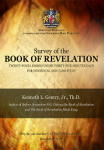
Survey of the Book of Revelation
(DVDs by Ken Gentry)
Twenty-four careful, down-to-earth lectures provide a basic introduction to and survey of the entire Book of Revelation. Professionally produced lectures of 30-35 minutes length.
See more study materials at: www.KennethGentry.com
And the eternal God will walk upon the earth, on Mount Sinai,… and the high mountains will be shaken and will fall and be dissolved and the high mountains will be made low so that the mountains will waste away [toiu diaruenai] and they will melt like wax before the fire in flame and the earth will be split apart and all the things upon the earth will perish (1 Enoch 6.3-7, translated from G; cf. Ps. 97.5, Zeph. 1.18).
As noted in our discussion of this passage in chapter three, this verse like 2 Peter 3 reflects more appropriately the OT theophanic texts which reveal through violent language God’s authority over his creation rather than total dissolution of the World (cf. Mic. 1.4; Nah. 1.5; Hab. 3.6).
The language of 2 Peter 3 nevertheless has suggested to some the influence of Greek cosmology. As mentioned, the Greeks envisioned world history in two movements each punctuated decisively by the destruction of the world by water and fire. In Plato’s Timaeus a legend is recounted regarding several destructions of humanity of which the greatest are by fire and water and the lesser ones by countless other means (22B-C). Interestingly, the term ekpurosis does not appear and the destruction by fire is described in the same manner as the flood by which the gods “purged” (kathairontes) the earth by water (22D). That the Stoic doctrine of was influential in Judaism even among the more reclusive Qumran sectarians was noted in the discussion of 1QH 3.29-36. In contrast to Jewish conceptions, the Stoic idea was based on an impersonal and mechanical cyclical cosmology in which the cosmos periodically dissolved into fire, its basic element, from which the world was reborn. Each “new” world, however, was identical to the former. The context of Peter’s teaching indicates that the conceptual matrix is found in the OT and Jewish apocalyptic traditions. The distinctiveness of the Jewish and Christian concept of a new creation in contrast to Stoic ideas is thus immediately apparent. As Riesner states, the Stoic expected a neos kosmos while 2 Peter anticipated a kainos ouranos kai ge kaine. The uniqueness is likewise evident in the hope of the new creation as the basis of ethical admonitions (v. 11). The worldview of the writer is therefore that of Jewish Christianity.
Understanding the Olivet Discourse 
By Ken Gentry
This 5 DVD lecture set was filmed at a Bible Conference in Florida. It explains the entire Olivet Discourse in Matt. 24–25 from the (orthodox) preterist perspective. This lecture series begins by carefully analyzing Matt. 24:3, which establishes the two-part structure of the Discourse. It shows that the first section of the Discourse (Matt. 24:4–35) deals with the coming destruction of the temple and Jerusalem in AD 70. This important prophetic event is also theologically linked to the Final Judgment at the end of history, toward which AD 70 is a distant pointer.
For more educational materials: www. KennethGentry.com
Whatever conclusions may be drawn from the passage regarding creation and cosmic hope, one must realize that 2 Peter 3 is first and foremost a text concerning the certain punishment of the wicked and reward for the righteous. The cosmic scope the destruction no doubt communicated to the scoffers not only the reality of judgment but that nothing or no one could escape the wrath of God. Furthermore, the anticipation of the day of the Lord functioned primarily to encourage righteous living in preparation for the “new heavens and new earth in which righteousness dwells” (vv. 13, 14). In this regard, Peter’s hesitancy to describe the new creation in vivid and picturesque detail betrays the NT concern more for who is coming rather than what is to come. 198 This statement, however, does not diminish the importance of the new creation for the who of the eschaton will be no other than the creator God.
The passage nevertheless reveals important information regarding the concept of the future of creation. The heavy barrage of words such as apoleias, apolesthai (vv. 7, 9), pur, puroumenoi (vv. 7, 12), kriseos (v. 7), luo (vv. 10, 243 11, 12), kausoumena (vv. 10, 12), and teketai (v. 12) reveal the violence of the devastation. An ultraliteral reading of such language, however, fails to recognize that Peter portrays the advent of God in typical theophanic language reflecting the terrible effects of God’s wrath upon the wicked that even will reach cosmic proportions. Nonetheless, this picture discloses a radical discontinuity between the old and the new world more than any other passage previously encountered in this study of the OT or NT. However, that the passage rejects the idea of total annihilation is evident from the author’s typological hermeneutic. The flood motif as a type of future judgment and deliverance for humanity and creation suggests that the author does not envision total destruction and a new creation ex nihilo, but as in God’s first intervention there will be a purging primarily related to sinful humanity. Further, a total and final desolation of the creation not only implies a Gnostic view which denigrates the present created order but also denies the redemptive aspect even in the judgment of God. Judgment is not the last word; it is merely the prelude to the new heavens and new earth. Notably, the overwhelming influence of the OT in 2 Peter 3, as a glance at the NA reveals, makes it clear that Peter does not depart from the OT hope of a new creation which especially in Isaiah 65 reflects a continuity with the old creation.
2 Peter thus speaks of a radical discontinuity and continuity. The old world purged from corruption through the refining fires of God has given way to a new order. This hope of the new heavens and new earth rejects Käsemann’s assertion that 2 Peter evinces “the relapse of Christianity into Hellenistic dualism.” According to Käsemann, the writer stands apart from the Pauline doctrine of redemption “in a materialist sense.” 2 Peter reflects the believer’s longing for escape from the corruption of this world and the attainment of his ultimate destiny, namely, the participation in the divine phusis — apotheosis (cf. 1.4). On the contrary, the writer of 2 Peter has not altered the Pauline doctrine of redemption which includes all creation. Peter has no disdain for this world. He, like the other apocalyptists has a concern for the present created order. The “materialist” promise of the new heavens and new earth is opposed to a dualistic escape from the present world to another eternal, ethereal existence. 2 Peter 3 is entirely in accord with Paul’s concept of the freedom of creation (Rom. 8.21). In fact, although this passage represents a more radical break with the old world than does Romans 8, Beker’s statement with reference to Paul applies also to 2 Peter for both writers draw upon the same biblical and apocalyptic worldview that renounces the Gnostic contempt for this world and affirms the importance of the created order. God will not negate his creation. As Beker notes:
“Although the glory of God will break into our fallen world, it will not annihilate the world but only break its present structure of death, because it aims to transform the cosmos rather than to confirm its ontological nothingness.” (emphasis by Russell).
GOODBIRTH AND THE TWO AGES
I am currently researching a technical study on the concept of the Two Ages in Scripture. This study is not only important for understanding the proper biblical concept of the structure of redemptive history. But it is also absolutely essential for fully grasping the significance of the Disciples’ questions in Matthew 24:3, which spark the Olivet Discourse. This book will be the forerunner to a fuller commentary on the Olivet Discourse in Matthew’s comprehensive presentation. This issue must be dealt with before one can seriously delve into the Discourse itself.
If you would like to support me in my research, I invite you to consider giving a tax-deductible contribution to my research and writing ministry: GoodBirth Ministries. Your help is much appreciated! https://www.paypal.com/donate/?cmd=_s-xclick&hosted_button_id=4XXFLGKEQU48C&ssrt=1740411591428
March 18, 2025
NEW CREATION IN 2 PETER 3 (1)
PMW 2025-022 by David Russell
Gentry note: The following paragraphs are cited from David M. Russell, The “New Heavens and New Earth,” Philadelphia: Visionary, 1996, pp. 186–97. Though not agreeing with all of his arguments, I highly recommend this book. This will be presented in two posts.
2 Peter 3 is important for discussion not only because of the reaffirmation of Isaiah’s promise of the new heavens and new earth but as the most explicit statement in the Bible of the total destruction of the earth by fire. Conclusions regarding the teaching of the passage are far from evident and are immediately complicated due to text-critical matters and the general worldview of the author. These will be addressed in the course of the discussion of the text. Significantly, 2 Peter provides an appropriate vantage point for this study for it addresses three important aspects central to the concept of creation and cosmic hope: the creation and constancy of the created order (vv. 4-5), the world’s plight and judgment (vv. 6-7, 10-12), and the new creation (v. 13).
“3 Know this first of all, that in the last days mockers will 4 and saying, “Where is the come with their mocking, promise of His coming? For ever since the fathers fell asleep, all continues just as it was from the beginning of 5 For when they maintain this, it escapes their notice that by the word of God the heavens existed long and the earth was formed out of water and by water, through which the world at that time was destroyed, being flooded with water. 7 But the present heavens and earth by 10 But the day of the Lord 11 His word are being kept for the day of judgment and destruction of ungodly men… will come like a thief in which the heavens will pass away with a roar and the elements will be destroyed with intense heat, and the earth and its works will be burned up. Since all these things are to be destroyed in this way, what sort of people ought you to be in holy conduct and godliness, 12 looking for and hastening the coming of the day of God, on account of which the heavens will be destroyed by burning, and the elements will melt with intense heat! 13 But according to His promise we are looking for new heavens and a new earth, in which righteousness dwells.” (2 Peter 3.5-13)
THE APOCALYPSE OF JOHN
by Milton S. Terry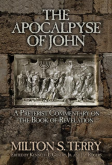
This book is Terry’s preterist commentary on the Book of Revelation. It was originally the last half of his much larger work, Biblical Apocalyptics. It is deeply-exegetical, tightly-argued, and clearly-presented.
For more study materials: https://www.kennethgentry.com/
In response to the taunts of those who see the delay of the Parousia as proof positive that judgment will never come, the author adduces the steadfastness of God’s word by which the World was created and by which he has determined its ultimate judgment. Peter asserts that all has not continued as normal since the beginning of the world. The world has once before experienced the mighty intervention of God and would do so again. The creation and flood, then, serve as types of judgment and renewal and ensure the reality of the future intervention of God. In the typological understanding of the biblical judgment in the end is thus predicated upon his activity as both creator and judge in the beginning. The verbal parallelism between verses 5 and 7 reveals that this typological emphasis is deliberate. Just as the old world was created by the word of God (to logo) and perished (apoleto) in the flood, so also will the present universe experience destruction (apoleias) by the same word (to logo). Likewise, the previous generation of Noah (cf. 2.5) corresponds to the present generation of scoffers who likewise deserve judgment (vv. 3-4) while Noah represents a typological model for the righteous. The entire section therefore reveals a typological hermeneutic.
Peter’s primary emphasis is upon the certainty of the parousia and the judgment of the wicked. Cosmological speculations reflected in these verses, while secondary, are not totally unrelated. For example, the writer’s terminology of the cosmos that existed “then” (ho tote kosmos, v. 6) and the present world (hoi nun ouranoi kai he ge, v. 7) as well as the new creation (v. 13) is not intended to suggest three entirely distinct worlds but reflects the apocalyptic idea of world history divided by two great cosmic upheavals. Notably, the reference to the destruction of the world in the deluge does not connote complete annihilation. In accordance with the OT tradition, it portrays the return of creation to its primeval chaotic state. Further, do verses 5-6 teach that the earth was formed “out of water” (ex hudatos, v. 5, NASB, NIV), that is, as the basic element of creation? It is possible that Peter intends a parallel with the Stoic motif of ekpurosis in which the cosmos dissolved periodically into fire (v. 10), the basic element of the universe. The phrase more likely recalls Gen. 1.6, 9 in which God confined the waters that the land might appear. (cf. Ps. 33.7; 104.5-6). The second phrase, di hudatos, “by means of water” (RSV, NEB) suggests, according to Green, the means by which the earth was sustained, that is, by rain. This, however, is not mentioned in Genesis 1 or 2. Bauckham contends plausibly that the writer has in mind the act of separating the waters.” As such the phrase is an alternative to the first and suggests that Peter is drawing upon the chaoskampf motif in which creation was wrought by means of the defeat of the watery primeval chaos. The problematic plural relative pronoun in verse 7, di on, refers to both the word and the waters as the basis and agent of creation and destruction. Significantly, 2 Pet. 3.5-7 maintains that unlike Hellenistic cosmology the world was created and continues to exist by God’s effective word (vv. 5, 7). The creation and its destiny therefore are not natural occurrences. Nature in biblical thought is not an autonomous, self-determinative system. Schelkle states appropriately that “the world is not nature, and its history is not natural, but it is creature, and its history is judgment and salvation.”
The certainty of universal judgment is assured by Peter’s statement that the present heavens and earth “stand reserved” for fire (v. 7). Yet this reality carries an unexpected and sudden quality for the “day of the Lord will come as a thief” (v. 10). God’s advent in judgment is accompanied by catastrophic events. The heavens will pass away “with a roar” (v. 10). The word roizedon, an onomatopoeic word, is used in Hellenistic to express the whizzing sound produced by rushing motion through air such as the flight of an arrow or a bird’s wings, and later by extension the rushing motion itself. Kelly thinks that the word connotes in this context the hissing, crackling, or roaring sound of uncontrollable and consuming blazes of fire. This noise also may represent the divine voice which like fire is often a standard element of theophanies (cf. Ps. 18.13-15; Joel 3.16; 1 Thess. 4.16). The event therefore is not merely one of destruction but pictures the arrival of the Lord himself in judgment. Peter also prophesies that the heavens will pass away and the “elements” (stoicheia) will melt with the intense heat (vv. 10, 12). Stoicheia may refer to the four elements of water, fire, air, and earth which in Stoic thought comprised the physical world. The term can also refer to the heavenly bodies. Schelkle suggests that since the stoicheia were sometimes conceived as celestial “powers” (Gal. 4.3), which in apocalyptic are represented by the stars, the writer might have combined the two meanings. However, the parallel of the heavens with the earth favors the reference to the heavenly bodies (cf. Isa. 34.4).
The Divorce of Israel: A Redemptive-Historical Interpretation of Revelation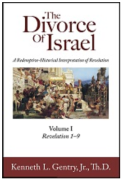
This long-awaited commentary has now been published. It is an 1800 page, two-volume deeply exegetical, academic commentary on the Bible’s most mysterious book.
Click: https://www.kennethgentry.com/the-divorce-of-israel-2-vols-by-gentry-pre-publication-offer/
See more study materials at: www.KennethGentry.com
The precise effect of the judgment theophany upon the earth is complicated because of the reading of the last word in the verse. Several English versions accept the reading eurethesetai but translate the verb “will be burned up” (NASB, RSV, NJB) even though it should be rendered “will be found.” This is no doubt an accommodation which attempts to understand the meaning of this difficult reading in the context of cosmic conflagration. Metzger declares that “the word seems to be devoid of meaning in this context.’ While this assessment is true, eurethesetai seems to be more original as the oldest reading and the one which best explains all the variants. The manuscript evidence reveals that this reading was often modified by additions, omitted altogether, or replaced by another verb in an attempt to harmonize the reading with the context. Additional conjectures have been proposed by modern commentators. Metzger, following Hort, suggests the reading of ruesetai or heurethesetai (“will waste away”) as a scribal corruption of euresthesetai. The verbs arthesetai (“will be taken away”) and krithesetai (“will be judged”) also have been recommended.
Other solutions have been offered which attempt to make the passage intelligible while also accepting eurethesetai as the original reading. Kelly ingeniously recommends punctuating the end of verse 10 as a question: “and the earth and the works it contains — will they be found?” This, however, has not recommended itself to scholars. Danker has argued that the reading is not unnecessarily difficult in the context if the meaning is understood properly. He objects that eurethesetai has often been regarded as unacceptable because commentators have tended to focus upon the mode of judgment, that is, the utter destruction of the earth. By contrast, the verb describes the judicial process involving the earth’s inhabitants and hence the meaning “will be judged.” The absolute use of the verb, however, requires Danker to emend the text. In comparison with similar wording in Ps. Sol. 17.10, he conjectures that the text to read: “the earth will be found judged according to the deeds done in it.” Bauckham and Schelkle accept the basic premise of this argument, but without The conjecture emendation. The entire context centers upon the judgment of the wicked rather than cosmic annihilation which is of interest to the writer only as a means of God’s judgment against humanity. The verse therefore ends on a note describing the exposure of human works. The wicked and their works “will be found,” that is, will be open to God’s scrutiny and condemnation. A view closely related but which does not confine the judgment process to human inhabitants is Wolters’ argument that Peter envisioned the day of the Lord as a smelting process from which the world “will be found” or “will emerge purified.” The description of the judgment by verbs meaning “to melt” (puroomai, v. 12) and to burn (kausoomai, v. 10, 12) portray the picture of intense heat without burning up completely. In keeping with the OT view of God as a refiner through fire the verb thus connotes “to have survived,” “to have stood the test,” “to have been found or proved genuine.” Wolters finds support for such an interpretation in 1 Pet. 1.17 where the passive of heurisko is used absolutely to denote surviving a purifying fire. The weakness of this view, as he admits, is that this meaning of heurisko is without lexical support outside the Petrine writings. This interpretation does, however, attempt to recognize the cosmic dimension of judgment while protecting against a Gnostic worldview which regards the world as expendable.’
To be continued!
GOODBIRTH AND THE TWO AGES
I am currently researching a technical study on the concept of the Two Ages in Scripture. This study is not only important for understanding the proper biblical concept of the structure of redemptive history. But it is also absolutely essential for fully grasping the significance of the Disciples’ questions in Matthew 24:3, which spark the Olivet Discourse. This book will be the forerunner to a fuller commentary on the Olivet Discourse in Matthew’s comprehensive presentation. This issue must be dealt with before one can seriously delve into the Discourse itself.
If you would like to support me in my research, I invite you to consider giving a tax-deductible contribution to my research and writing ministry: GoodBirth Ministries. Your help is much appreciated! https://www.paypal.com/donate/?cmd=_s-xclick&hosted_button_id=4XXFLGKEQU48C&ssrt=1740411591428
March 14, 2025
DABNEY ON THE RESURRECTION BODY (2)
PMW 2025-021 by Robert L. Dabney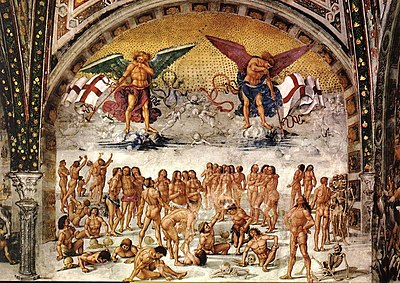
Note: This concludes our previous posting presenting Robert L. Dabney’s argument for the physical resurrection of the dead.
Objection From Wonderfulness, Answered
The general objection is from the incredible greatness of the work. That is, since the particles that composed human bodies are scattered asunder by almost every conceivable agency, fire, winds, waters, birds and beasts of prey, mingled with the soil of the fields, and dissolved in the waters of the ocean, it is unreasonable to expect they will be assembled again.
We reply (reserving the question whether a proper corporeal identity implies the presence of all the constituent particles; of which more shortly), that this objection is founded only on a denial of God’s omnipotence, omniscience, and almighty power. The work of the resurrection does indeed present a most wondrous and glorious display of divine power. But to God all things are easy.
Indeed, we may briefly reply, that to all who believe in a special Providence, there is a standing and triumphant answer visible to our eyes. It is in the existence of our present bodies. Are they not formed by God? Are they not also formed from “the dust of the earth?” And it is not any one hundred and fifty pounds of earth, which God moulds into a body of that weight. But there is a most wonderful, extensive, and nice selection of particles, where a million of atoms are assorted over and rejected, for one that is selected; and that from thousands of miles. In my body there are atoms, probably, that came from Java (in coffee), and from Cuba or Manilla (in sugar), and from the western prairies (in pork), and from the savannahs of Carolina (in rice), and from the green hills of Western Virginia (in beef and butter), and from our own fields (in fruits). Do you say, the selection and aggregation have been accomplished gradually, by sundry natural laws of vegetation and nutrition? Yes, but what are natural laws? Only regular modes of God’s working through matter, which He has in His wisdom proposed to Himself! If God actually does this thing now, why may He not do another thing just like it, only more quickly?
Physical Objection Answered
But an objection supposed to be still more formidable, is derived from the supposed flux of particles in the human body. And even further from the cases in which particles which belonged to one man at his death, become parts of the structure of another man’s body. This may happen through cannibalism, or the derivation by beasts from the mould enriched with human dust, which beasts are in turn consumed by men, etc. Now, since one material atom cannot be in two places at the same time, the resurrection of the same bodies, say they, is a physical impossibility. And if the flux of particles be admitted, which shall the man claim, as composing his bodily identity: those he had first, or those he had last — or all he ever had?
The Truth about Postmillennialism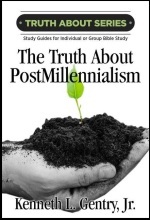 By Ken Gentry
By Ken Gentry
A group Bible study guide for explaining the optimistic prophetic hope for this world to be accomplished before Christ’s Second Coming. Establishes the postmillennial system in both the Old and New Testaments. Touches on key eschatological issues, such as creation, covenant, interpretive methodolgy, the great tribulation, the Book of Revelation, the Jewish Temple, and more. It presents and answers the leading objections to postmillennialism.Twelve chapters are ideal for one quarter of Sunday School.
See more study materials at: www.KennethGentry.com
To the first of these questions, we reply that there is no evidence that a particle of matter composing a portion of a human corpse, has ever been assimilated by another human body. It is only assumed that it may be so. But now, inasmuch as the truth of Scripture has been demonstrated by an independent course of moral evidences, and it asserts the same body shall be raised, if there is, indeed, any difficulty about this question of the atoms, the burden of proof lies upon the objector. And he must demonstrate that the difficulty exists, and is insuperable. It is not sufficient merely to surmise that it may exist.
Now, I repeat, a surmise is good enough to meet a surmise. Let me assume this hypothesis, that
it may be a physiological law that a molecule, once assimilated and vitalized by a man (or other animal), undergoes an influence which renders it afterwards incapable of assimilation by another being of the same species. This, indeed, is not without plausible evidence from analogy: witness, for instance, the fertility of a soil to another crop, when a proper rotation is pursued, which had become barren as to the first crop too long repeated. But, if there is any such law, the case supposed by the objector against the resurrection, never occurs.
And, second, in answer to both objections, it can never be shown that the numerical identity of all the constituent atoms is necessary to that bodily sameness, which is asserted by the Bible of our resurrection bodies. We are under no forensic obligation whatever, to define precisely in what that sameness consists. But we take our stand here, that the Bible, being written in popular language, when it says our resurrection bodies will be the same, it means precisely what popular consciousness and common language apprehend when it is said my body at forty is the same body grown stronger, which I had at fifteen.
Let that meaning be whatever it may be. If this doctrine of the flux of particles, and this possibility of a particle that once belonged becoming a part of another, prove that our resurrection bodies cannot be the same that died: they equally prove for that flux, if there is any truth in it, has already occurred. That is, that my body cannot now be the body I had some years ago. And there is just as much probability that I have been nourished with a few particles from a potato, manured with the hair of some man who is still living, as that two men will both claim the same particles at the resurrection.
But my consciousness tells me (the most demonstrative of all proof), that I have had the same body all the time, so that, if these famous objections disprove a resurrection, they equally contradict consciousness. You will notice that I propound no theory as to what constitutes precisely our consciousness of bodily identity, as it is wholly unnecessary to our argument that I should. Nor do I undertake to define precisely how the resurrection body will be constituted in this particular. And this is most proper for me, because the Bible propounds no theory on this point.
But if curiosity leads you to enquire, I answer that it appears to me our consciousness of bodily identity (as to a limb, or member, or organ of sense, for instance) does not include an apprehension of the numerical identity of all the constituent atoms all the while. Rather that it consists of an apprehension of a continued relation of the organism of the limb or organ to our mental consciousness all the time, implying also that there is no sudden change of a majority, or even any large fraction of the constituent atoms thereof at any one time.
 The Truth about Salvation By Ken Gentry
The Truth about Salvation By Ken Gentry
A study guide for personal or small group Bible study. Deals with the Christian doctrine of salvation from a Reformed theological perspective. It opens with a study of God as loving Creator, the shows how the first man fell into sin. Shows God’s righteousness requires that sin be dealt with. Presents Jesus as both God and man so that he can be man’s Savior. Includes review questions and questions for further study.Twelve chapters are ideal for one quarter of Sunday School.
See more study materials at: www.KennethGentry.com
Proofs That Bodies Will Rise
In presenting the Bible-proof, nothing more will be done, than to cite the passages, with such word of explanation as may be necessary to show their application. If we believe our Saviour, implications of this doctrine appear at a very early stage of the Old Testament Scriptures. For indeed the sort of immortality implied all along, is the immortality of man, body and soul (see Exo. 3:6, as explained in Matt. 22:31–32; Mark 12:26–27).
The next passage is Job 19:26, which I claim quicunque vult, as containing a clear assertion of a resurrection. In Psalm 26:9, 11 (expounded in Acts 2:29, 32; 13:36–37) David is made by the Holy Ghost to foretell Christ’s resurrection. Doubtless, the Psalmist, if he distinctly knew that he was personating Christ in this language, apprehended his own resurrection as a corollary of Christ’s. Psalm 17:15 probably alludes also to a resurrection in the phrase: “awake in thy likeness;” for what awakes, except the body? Nothing else sleeps. So Isaiah 25:8 may be seen interpreted in 1 Corinthians 15:54; Daniel 12:2. Both teach the same doctrine.
In the New Testament the proofs of bodily resurrection are still more numerous and explicit. The following are the chief: Matthew 22:31, etc.; Mark 12:26–27; John 5:21, 29; 6:39–40; 11:24; Acts as above; 1 Corinthians 15; 1 Thessalonians 4:13ff.; 2 Timothy 2:8; Philippians 3:21; Hebrews 6:2; 11:35.
Other strong Scriptural proofs are urged by the Reformed divines, which need little more than a mere statement here. The resurrection of Christ is both the example and proof of ours (1 Cor. 15:20; 1 Pet. 1:3). First, it demonstrates that the work is feasible for God. Second, it demonstrates the sufficiency and acceptance of Christ’s satisfaction for His people’s guilt. But bodily death is a part of our penalty therefor: and must be repaired when we are fully invested with the avails of that purchase. Third, Scripture shows such a union between Christ, the Head, and His members, that our glorification must result as His does (1 Cor. 6:15).
The exposition given of the Covenant of Grace, by our Saviour Himself in Matthew 22:31, etc., shows that it includes a resurrection for the body. This covenant, Christ there teaches us, is first, perpetual: death does not sever it. But second, it was a covenant not between God and angels or ghosts, but between Him and the incorporate men, Abraham, Isaac, and Jacob. Then, its consummation must restore them to their incorporate state.
The inhabitation of our bodies by the Holy Ghost implies the redemption of the body also. Although not the primary seat of sanctification, the body, thus closely dedicated to the Spirit’s indwelling, will not be left in the dust (Rom. 8:11).
Last, we have seen Turrettin unfold the reasonableness of men’s being judged in the bodies in which they have lived. The rewards and penalties cannot, in any other way, be so appropriate, as when God makes the bodily members which were abused or consecrated, the inlets of the deserved penalties, or the free rewards (1 Cor. 5:10).
[image error]Why I Left Full-Preterism (by Samuel M. Frost)
Former leader in Full Preterist movement, Samuel M. Frost, gives his testimony and theological reasoning as to why he left the heretical movement. Good warning to others tempted to leave orthodox Christianity.
See more study materials at: KennethGentry.com
Reprobate not raised in Christ, but by Christ
Some divines, as e. g. Breckinridge, say that the resurrection of both saints and sinners is of Christ’s purchase, quoting 1 Corinthians 15:22, making the “all” mean the whole human race. But we teach, that while Christ, as King in Zion, commands the resurrection of both, it is in different relations. The resurrection of His people being a gift of His purchase, is effectuated in them by the union to Him, and is one result of the indwelling of the Holy Ghost. The resurrection of the evil is an act of pure dominion, effected in them by His avenging sovereignty. The other idea would represent the wicked also, as vitally connected with Christ, by a mystical union. But if so, why does not that union sanctify and save? Are we authorized to say that, had Christ not come, there would have been no resurrection unto damnation for Adam’s fallen race at all? Moreover, that opinion puts an unauthorized and dangerous sense upon 1 Corinthians 15:22 and similar verses.
GOODBIRTH AND THE TWO AGES
I am currently researching a technical study on the concept of the Two Ages in Scripture. This study is not only important for understanding the proper biblical concept of the structure of redemptive history. But it is also absolutely essential for fully grasping the significance of the Disciples’ questions in Matthew 24:3, which spark the Olivet Discourse. This book will be the forerunner to a fuller commentary on the Olivet Discourse in Matthew’s comprehensive presentation. This issue must be dealt with before one can seriously delve into the Discourse itself.
If you would like to support me in my research, I invite you to consider giving a tax-deductible contribution to my research and writing ministry: GoodBirth Ministries. Your help is much appreciated! https://www.paypal.com/donate/?cmd=_s-xclick&hosted_button_id=4XXFLGKEQU48C&ssrt=1740411591428
March 11, 2025
DABNEY ON THE RESURRECTION BODY (1)
PMW 2025-020 by Robert L. Dabney
Gentry note:
R. L. Dabney (1820–98) was a Reformed Presbyterian theologian who served as professor of systematic theology ot Union Theological Seminary (back when it believed something in particular), then he served as Professor of Mental and Moral Philosophy at the University of Texas. This excerpt below is from pp. 832–34 of his Lectures in Systematic Theology. Please note: I have slightly tweaked some of his punctuation, Roman numerals, and nineteenth century style without changing his meaning.
True Meaning of Resurrection
In Scripture the image of a resurrection, anastasis, is a undoubtedly used sometimes in a figurative sense, to describe regeneration (John 5:25; Eph. 5:14). And sometimes to speak of restoration from calamity and captivity to prosperity and joy (Ezek. 37:12: Isa. 26:19). But it is equally certain that the words are intended to be used in a literal sense, of the restoration of the same body that dies to life, by its reunion to the soul. This then is the doctrine. For when the resurrection of the dead (nekron), of those that are in their graves, of those that sleep in the dust of the earth, is declared, the sense is unequivocal. Without at this time particularizing Scripture proofs, we assert that they mean to describe a bodily existence as literally as when they speak of man’s soul in in this life, as residing in a body. And this, though wonderfully changed in qualities, is the same body in the proper, honest sense of the word “same,” which the soul laid down at death. This resurrection will embrace all the individuals of the human race, good and bad, except those whose bodies have already passed into heaven, and those of the last generation, who will be alive on the earth at the last trump. But on the bodies of these the resurrection change will pass, though they do not die. The signal of this resurrection is to be the “last trump,” an expression probably taken from the transactions at Sinai (Exo. 19:16, 19; cf. Heb. 12:26), which may, very possibly, be some literal, audible summons, sounded through the whole atmosphere of the world. But the agent will be Christ, by His direct and almighty power, with the Holy Ghost.
Qualities of Resurrection Bodies
The qualities of the resurrection bodies of the saints are described in 1 Corinthians 15:42, 50, with as much particularity, probably, as we can comprehend. Whereas the body is buried in a state of dissolution, it is raised indissoluble, no longer liable to disorganization, by separation of particles. This is either because protected therefrom by the special power of God or by the absence of assailing chemical forces. It is buried, disfigured and loathsome; it will be raised beautiful. Since it is a literal material body that is raised, it is far the most natural to suppose that the glory predicated of it, is literal, material beauty.
Reformed Eschatology in the Writings of Geerhardus Vos
Ed. by Ken Gentry and Bill Boney
This is a collection of several key eschatological studies by the renowned Reformed theologian Geehardus Vos. We have modernized Vos’ grammar and syntax and updated his layout style according to modern publishing conventions (shorter sentences and paragraphs). We did this without changing any of Vos’ arguments.
For more information on this new Vos work or to order it, see:
https://www.kennethgentry.com/reformed-eschatology-in-the-writings-of-geerhardus-vos/
As to its kind, see Matthew 13:43 and Philippians 3:21, with Revelation 1:13–14. Some may think that it is unworthy of God’s redemption to suppose it conferring an advantage so trivial and sensuous as personal beauty. But is not this a remnant of that Gnostic or Neo-Platonic asceticism, which cast off the body itself as too worthless to be an object of redeeming power? We know that sanctified affections now always beautify and ennoble the countenance (see Exo. 34:29–30). And if God did not deem it too trivial for His attention, to clothe the landscape with verdure, to cast every form of nature in lines of grace, to dye the skies with purest azure, and to paint the sun and stars with splendour, in order to gratify the eyes of His children here, we may assume that He will condescend to beautify even the bodies of His saints, in that world where all is made perfect. Next, the body is buried in weakness; it has just given the crowning evidence of feebleness, by yielding to death. It will be raised in immortal vigour, so as to perform its functions with perfect facility, and without fatigue.
And last, it is buried an animal body; i. e., this is the “natural body” character it has hitherto had. The soma psuchikon is unfortunately translated “natural body” in the English version (1 Cor. 15:44). The Apostle here evidently avails himself of the popular Greek distinction, growing out of the currency of Pythagorean and Platonic philosophy, to express his distinction, without meaning to endorse their anthropology.
The soma psuchikon is evidently the body as characterized chiefly by its animal functions. What these are, there can be little doubt, if we keep in mind the established Greek sense of the psuche, viz: the functions of the appetite and sense. Then the soma pneumatikon must mean not a body now material, as the Swedenborgians, etc., claim (a positive contradiction and impossibility), but a body actuated only by processes of intellection and moral affection. For these, Paul’s readers supposed were the proper processes of the pnuema or nous.
But the Apostle in verses 44 and 50, defines his own meaning. To show that “there is an animal body, and a spiritual body.” That it is no fancy nor impossibility, he points to the fact that such have already existed, in the case of Adam and his natural seed, and of Christ. And as we were federally connected, first with Adam, and then with Christ, we bear first the animal body, (Adam’s) and then the spiritual (Christ’s). And Christ’s humanity also, during His humiliation, passed through that first stage, to the second because he assumed all the innocent weaknesses and affections of a literal man.
Our soma pneumatikon, then, is defined to be what Christ’s glorified body now in Heaven is. Complete this definition by what we find in Matthew 22:30. The spiritual body then, is one occupied and actuated only by the spiritual processes of a sanctified soul, but which neither smarts with pain, nor feels fatigue, nor has appetites, nor takes any literal, material supplies therefor.
Three Views on the Millennium and Beyond
(ed. by Darrell Bock)
Presents three views on the millennium: progressive dispensationalist, amillennialist, and reconstructionist postmillennialist viewpoints. Includes separate responses to each view. Ken Gentry provides the postmillennial contribution.
See more study materials at: www.KennethGentry.com
Resurrection Bodies of Sinners
It seems every way reasonable to suppose that the bodies of the wicked will be raised without the glory or splendour of the saints. Yet they also will be no longer animal bodies, and will be endued with immortal vigour to endure. The Scriptures plainly teach that our resurrection bodies will be the bodies we now have, only modified — that is, that they will be substantially identical. This follows from the divine justice, so far as it prompts God to work a resurrection. For if we have not the very body in which we sinned, when called to judgment, that “every man may receive the things done in the body,” there will be no relevancy in the punishment, so far as it falls on the body.
GOODBIRTH AND THE TWO AGES
I am currently researching a technical study on the concept of the Two Ages in Scripture. This study is not only important for understanding the proper biblical concept of the structure of redemptive history. But it is also absolutely essential for fully grasping the significance of the Disciples’ questions in Matthew 24:3, which spark the Olivet Discourse. This book will be the forerunner to a fuller commentary on the Olivet Discourse in Matthew’s comprehensive presentation. This issue must be dealt with before one can seriously delve into the Discourse itself.
If you would like to support me in my research, I invite you to consider giving a tax-deductible contribution to my research and writing ministry: GoodBirth Ministries. Your help is much appreciated! https://www.paypal.com/donate/?cmd=_s-xclick&hosted_button_id=4XXFLGKEQU48C&ssrt=1740411591428
The same truth follows from the believer’s union to Christ. If He redeemed our bodies, must they not be the very ones we have here (1 Cor. 3:16; 6:15)? It appears evidently, from Christ’s resurrection, which is the earnest, exemplar, and pledge of ours. For in His case, the body that was raised was the very one that died and was buried. But if, in our case, the body that dies is finally dissipated, and another is reconstructed, there is small resemblance indeed to our Saviour’s resurrection.
This leads us to remark, fourth, that the very words anistimi, anastasis plainly imply the rearing of the same thing that fell — otherwise there is an abuse of language in applying them to a proper creation.
Last, the language of Scripture in Daniel 12:2; John 5:28–29; 1 Corinthians 15:21, 53, 54; 1 Thessalonians 4:16: it is that which is “in the dust of the earth,” “in the mnemeia,” the nekroi, corpses, which is raised. It is “this mortal” which “puts on immortality.” From the days of the Latin Fathers, and their speculative Pagan opposers, certain objections have been pompously raised against such a resurrection, as though it were intrinsically absurd. They may be found reproduced by George Bush on the Resurrection.
To be continued.
Tongues-speaking: Meaning, Purpose, and Cessation
 by Ken Gentry
by Ken Gentry
The position presented within is that tongues-speaking allowed the gift person to speak in a known human language without previously knowing it; tongues brought inspired revelation from God; the gift was a sign confirming the apostolic witness and warning of the coming destruction of Jerusalem; and therefore the gift ceased in the first century.
See more study materials at: www.KennethGentry.com
March 7, 2025
CHRISTIANITY AND FUTURE REVIVAL
PMW 2025-019 by O. T. Allis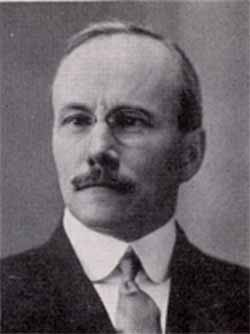
Gentry note:
O. T. Allis (1880-1973) was an internationally recognized philologist and Reformed theologian who helped found Westminster Theological Seminary, along with J. Gresham Machen, Robert Dick Wilson, and others. He is noted especially for his work in the Old Testament. Allis was a postmillennialist, as we can see from his Foreword in Roderick Campbell’s Israel and the New Covenant, a powerful postmillennial book. The following is his Foreword in full.
The author of this valuable contribution to Biblical Interpretation belongs to a class of writers which is not as numerous today as has sometimes been the case, the lay theologian. Being both an earnest and active Christian and a successful man of business, Mr. Campbell very naturally became, as he tells us in his Preface, deeply concerned over the economic depression and the moral degeneracy which followed in the wake of the first World War. Being a Christian he turned to the Bible for the answer; and he also consulted many of the ablest interpreters of the Bible, in the hope of solving this pressing problem. The answer which he found is the thesis of the present volume. It can be stated briefly and in a single sentence: The Christian church has for centuries failed to take seriously and carry out fully the Great Commission.
When the present is uncertain and the future dark and ominous, there is likely to be a far greater concern regarding “the things that are coming and shall come” than there is when “all the earth sitteth still, and is at rest.” It is when the foundations seem to be removed, that men ask anxious questions. The worldly ask them of the philosopher, the statesman, the political economist, even of the star-gazer and charlatan. The Christian turns to the Bible. We naturally expect the answers of the worldly-wise to be varied and even contradictory, a babel of conflicting opinions. But it is a significant as well as a deplorable fact that, among those who profess to go to the Bible for the answer, the solutions offered are in some respects almost equally various and conflicting.

He Shall Have Dominion
(paperback by Kenneth Gentry)
A classic, thorough explanation and defense of postmillennialism (600+ pages). Complete with several chapters answering specific objections.
See more study materials at: www.KennethGentry.com
Is there any way out of the labyrinth of confused terminology and conflicting interpretations which envelops and befogs so much of the current discussion of the Christian Hope? Is it possible for earnest Christians to attain to a practical measure of agreement regarding the meaning of the words of the angelic proclamation, “Glory to God in the highest and on earth peace, good will toward men,” of the oft-recited petition, “Thy kingdom come. Thy will be done in earth, as it is in heaven,” and of the glorious affirmation of the risen Christ, “Behold, I make all things new”? Must we be content to remain in a state of controversy, of uncertainty, or of indifference regarding the objective which has been set before the church of Christ, or the means of its successful accomplishment? These are some of the questions with which this book deals and for which it offers a clear and definite answer, an answer which will sound strange and novel to many ears, but which for that very reason may well deserve a careful and attentive hearing.
Mr. Campbell is well-read in the relevant literature and he is quite familiar with the questions under debate. As a result of his studies he has come to the definite conclusion that the whole subject of the Christian task and hope needs to be restudied from a different viewpoint and with a different emphasis. He has indicated this in the title which he has chosen for his book, Israel and the New Covenant. He finds the key to the problem of the duty and the destiny of the church in the covenants which are set forth so plainly in the Bible, notably the Abrahamic, the Mosaic, the Davidic, and the New Covenant of our Lord and Saviour Jesus Christ. He is convinced that in the promise given to Abraham, “in thy seed shall all the nations of the earth be blessed,” we have the Old Testament prediction of the task assigned to the Christian church in the Great Commission. He does not accept what he calls the “easy” solution of the problem, according to which we are to accept the failure of the church to win the world for Christ as evidence that this is not really the task of the church, and that we are to expect Lord by His coming and visible reign to accomplish the task of establishing His kingdom upon earth. He tells us very definitely that this task is assigned to the church; and he challenges her to bestir herself for its achievement. For he believes, that it is only when the church has accomplished the task assigned her, that she can expect her Lord to say unto her, “Well done good and faithful servant,” and to receive her unto Himself. This is the reason that the constant emphasis in the book so the present task of the church as the ambassador of Christ to a needy, sin-cursed world.
Thine Is the Kingdom
(ed. by Ken Gentry)
Contributors lay the scriptural foundation for a biblically-based, hope-filled postmillennial eschatology, while showing what it means to be postmillennial in the real world.
See more study materials at: www.KennethGentry.com
It is to be carefully noted that Mr. Campbell does not claim to be presenting a new interpretation, but rather a teaching which has been widely held in the past and by able scholars, an interpretation which can only be called novel, because it has been largely obscured by the quite different teachings which are so popular today. This is made clear by the footnotes which form a valuable addition to and confirmation of the argument presented in the text.
GOODBIRTH AND THE TWO AGES
I am currently researching a technical study on the concept of the Two Ages in Scripture. This study is not only important for understanding the proper biblical concept of the structure of redemptive history. But it is also absolutely essential for fully grasping the significance of the Disciples’ questions in Matthew 24:3, which spark the Olivet Discourse. This book will be the forerunner to a fuller commentary on the Olivet Discourse in Matthew’s comprehensive presentation. This issue must be dealt with before one can seriously delve into the Discourse itself.
If you would like to support me in my research, I invite you to consider giving a tax-deductible contribution to my research and writing ministry: GoodBirth Ministries. Your help is much appreciated! https://www.paypal.com/donate/?cmd=_s-xclick&hosted_button_id=4XXFLGKEQU48C&ssrt=1740411591428
I have known Mr. Campbell personally for a number of years; and I have discussed with him many of the problems dealt with in this book. So I count it a privilege to write a word of commendation of a work on which he has spent many years of careful study and research. I do this the more gladly because my own studies in this and related fields have convinced me that the most serious error in much of the current “prophetic” teaching of today is the claim that the future of Christendom is to be read not in terms of Revival and Victory, but of growing impotence and apostasy, and that the only hope of the world is that the Lord will by His visible coming and reign complete the task which He has so plainly entrusted to the church. This claim is rendered formidable and persuasive by the all too obvious fact of the past failures and present feebleness of the church. But it is pessimistic and defeatist. I hold it to be unscriptural. The language of the Great Commission is world-embracing; and it has back of it the authority and power of One who said: “All power is given unto me in heaven and in earth. Go ye therefore and make disciples of all nations.” The duty of the church is to address herself to the achieving of this task in anticipation of her Lord’s coming, and not to expect Him to call her away to glory before her task is accomplished. In a word, this book is both a challenge and a tonic for an enfeebled and discouraged church. May it have a wide and sympathetic reading. — OSWALD T. ALLIS
Click on the following images for more information on these studies:

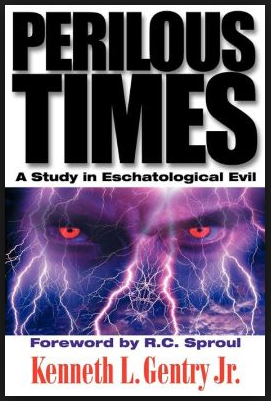
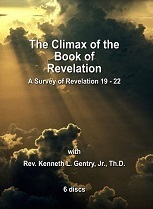
Kenneth L. Gentry Jr.'s Blog
- Kenneth L. Gentry Jr.'s profile
- 85 followers



